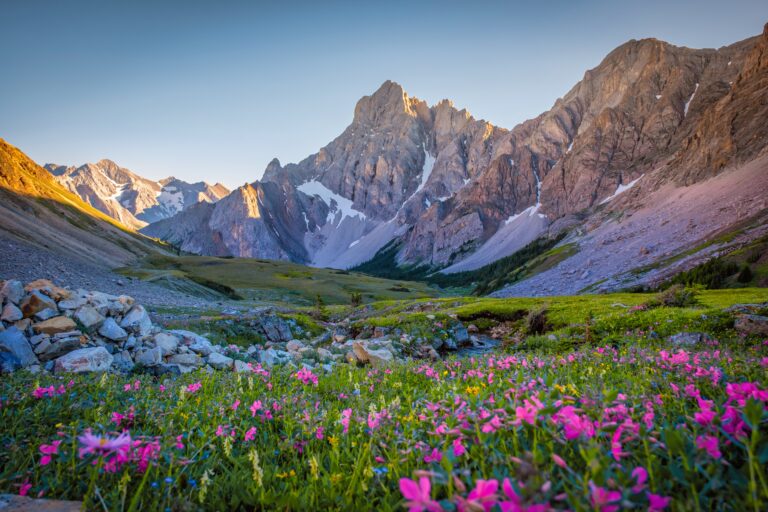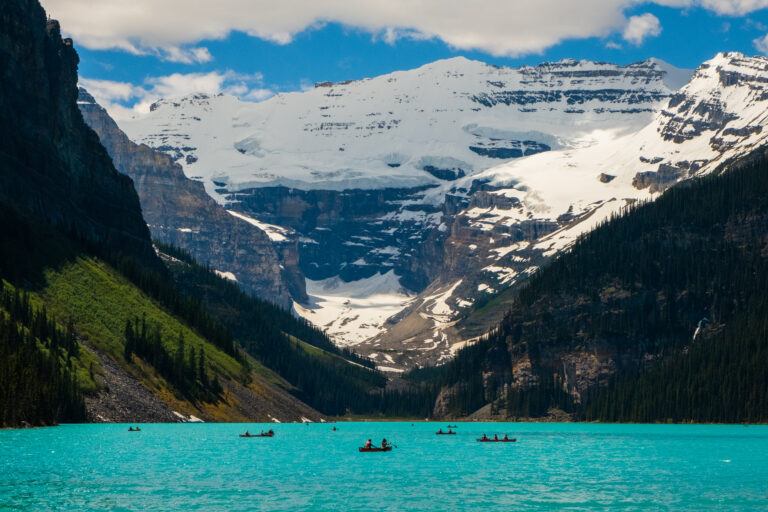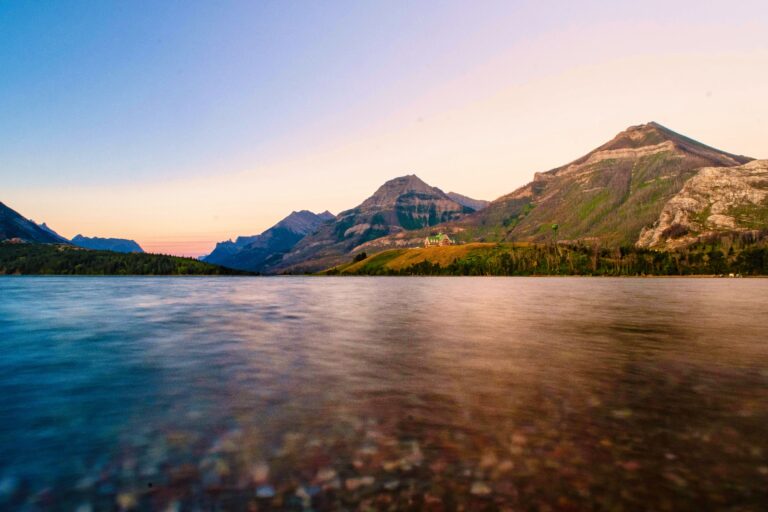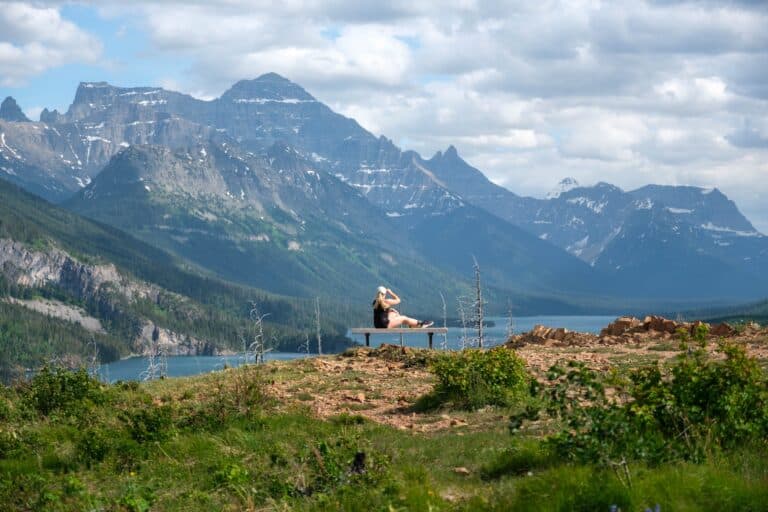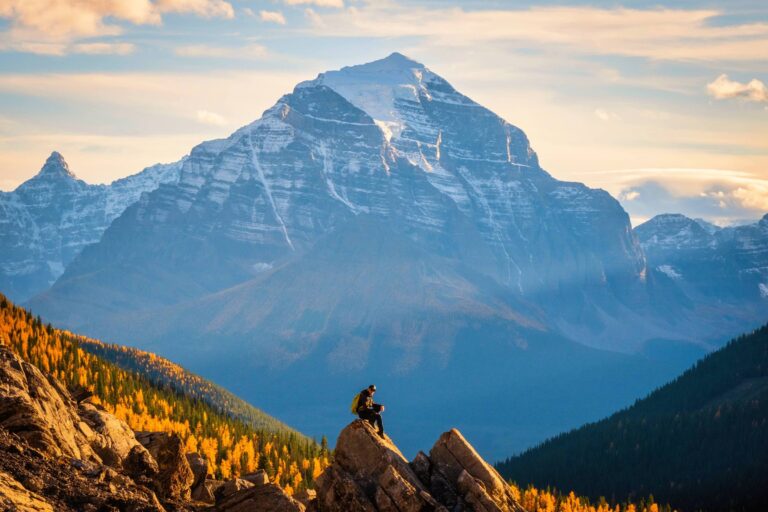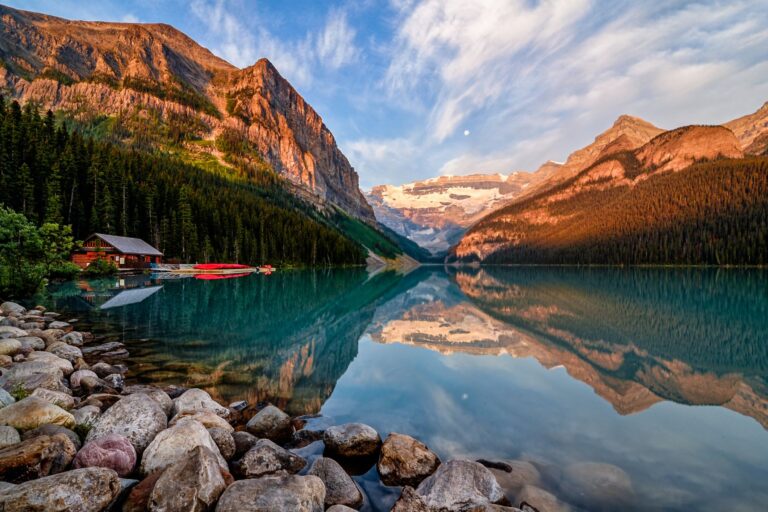What To Wear In Banff In Winter
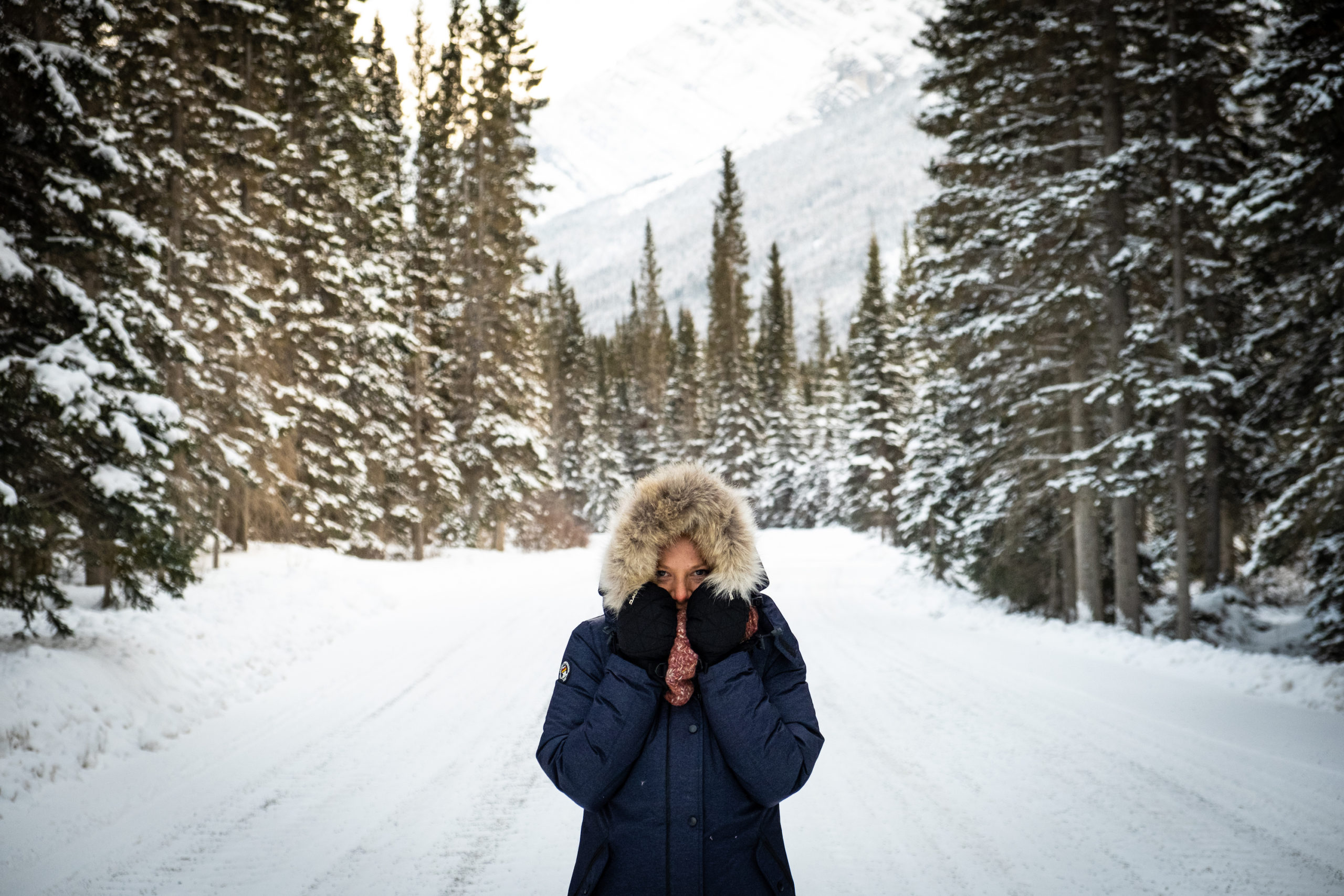
If you need guidance on what to wear in Banff in winter, we have the perfect packing list. It’s best to come prepared because winter in the Canadian Rockies can be frigid. Winter temps in Banff can alternate between 3C° to -5 C°,, down to a whopping -40 C° – yikes – that’s the same in both Celcius and Fahrenheit. Temperatures can be extreme here in Alberta, or they can be mild. One thing is certain, it’s the mountains, and you never know what you’ll get!
Never fear – the most extreme temperatures happen only a few times in the winter. Plus, with proper packing and the right clothes, we rarely let the cold deter us from enjoying the beauty of the Canadian Rockies. You’ve probably heard this before, but the key to staying warm in winter is layers. This means a solid exterior layer in the form of a warm jacket.
The last one is super important as the wind can pull the heat away from your body and leave you feeling much colder. Let’s dig into our complete winter packing list for the Canadian Rockies.
What to Wear in Banff in Winter
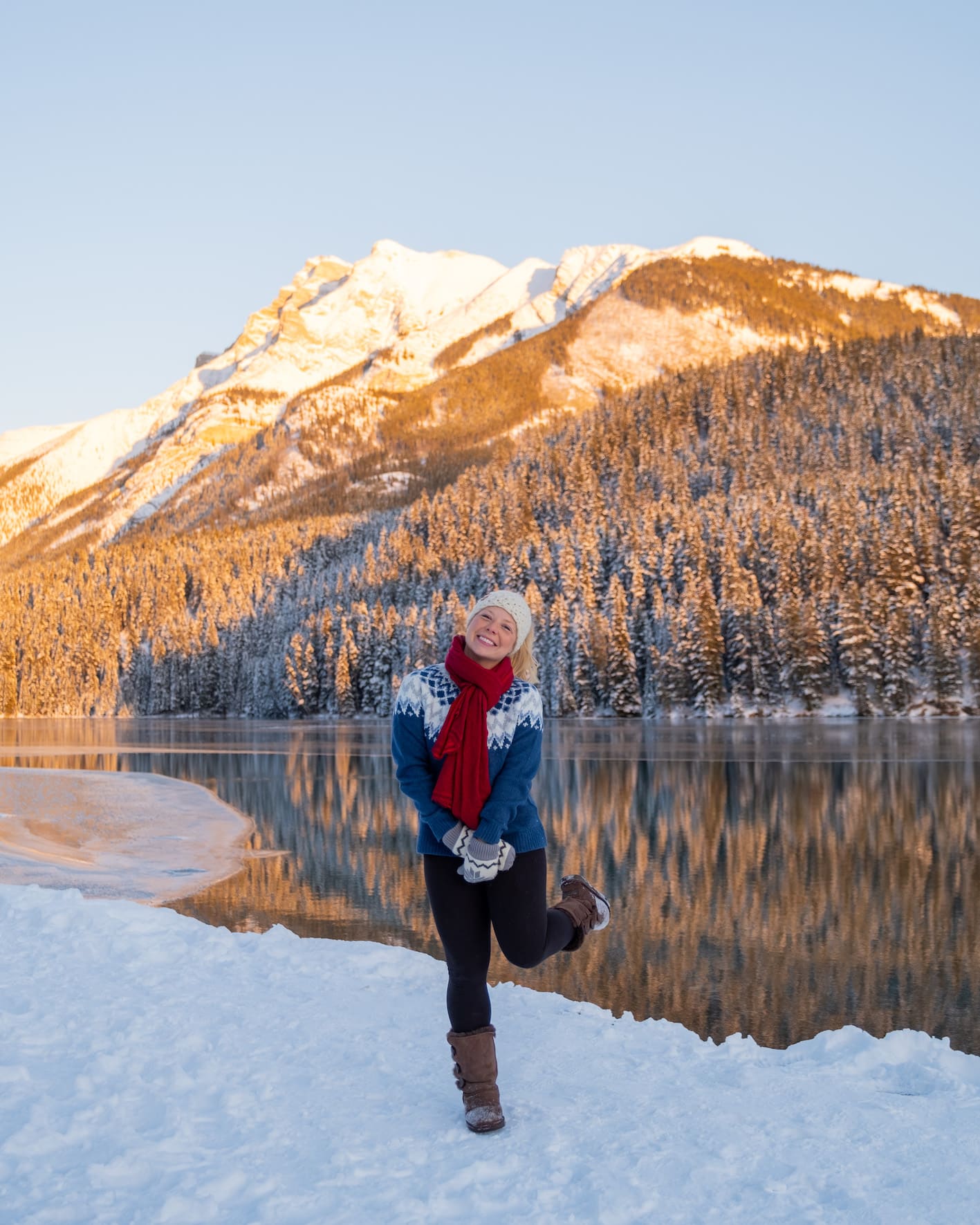
Here is a short rundown which includes ski/snowboarding gear and winter fun clothes. We’re active individuals and love winter sports, so you’ll find a good mix of lifestyle clothes and technical apparel for winter weather. This packing list is just to give you an idea of what’s helpful to pack for Banff in the winter. Of course, you know your wardrobe best!
- Winter Parka
- Down Jacket
- Sweater
- Flannel
- Casual Pants
- Fleece lined leggings
- 1 x Top Base Layer
- 1 x Bottom Base Layer
- 2-3 x Wool Underwear
- 2-3 x Wool Socks
- 1 x Mid-Layer Jacket
- 1 x Insulated Jacket
- 1 x Snow Pants
- 1 x Mitts or Gloves
- 1 x Balaclava
- 1 x Buff Headwear
- 1 x Goggles (if skiing or snowboarding)
- 1 x Helmet* (if skiing or snowboarding)
Dress For Your Winter Activities
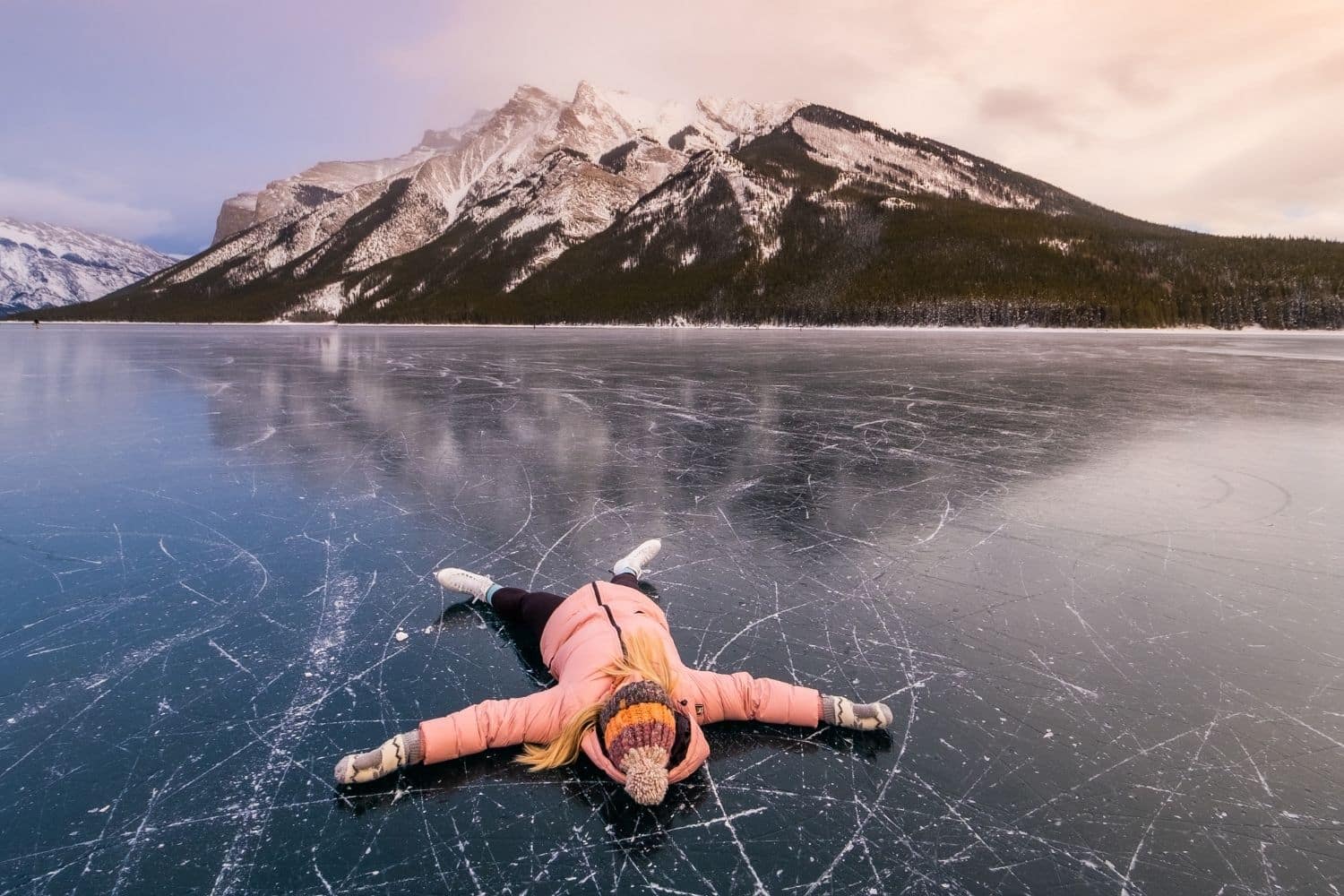
Don’t just think of nice outfits and sweaters when thinking about what to wear in Banff in winter. Just because there is snow on the ground doesn’t mean you can’t be active in the winter. We’re big winter sports fans, and there are many things to do in Banff in the winter. Some of our favorite things to do in the winter are ice skating, snowshoeing, ice climbing, snowboarding/skiing, and even a nice winter hike.
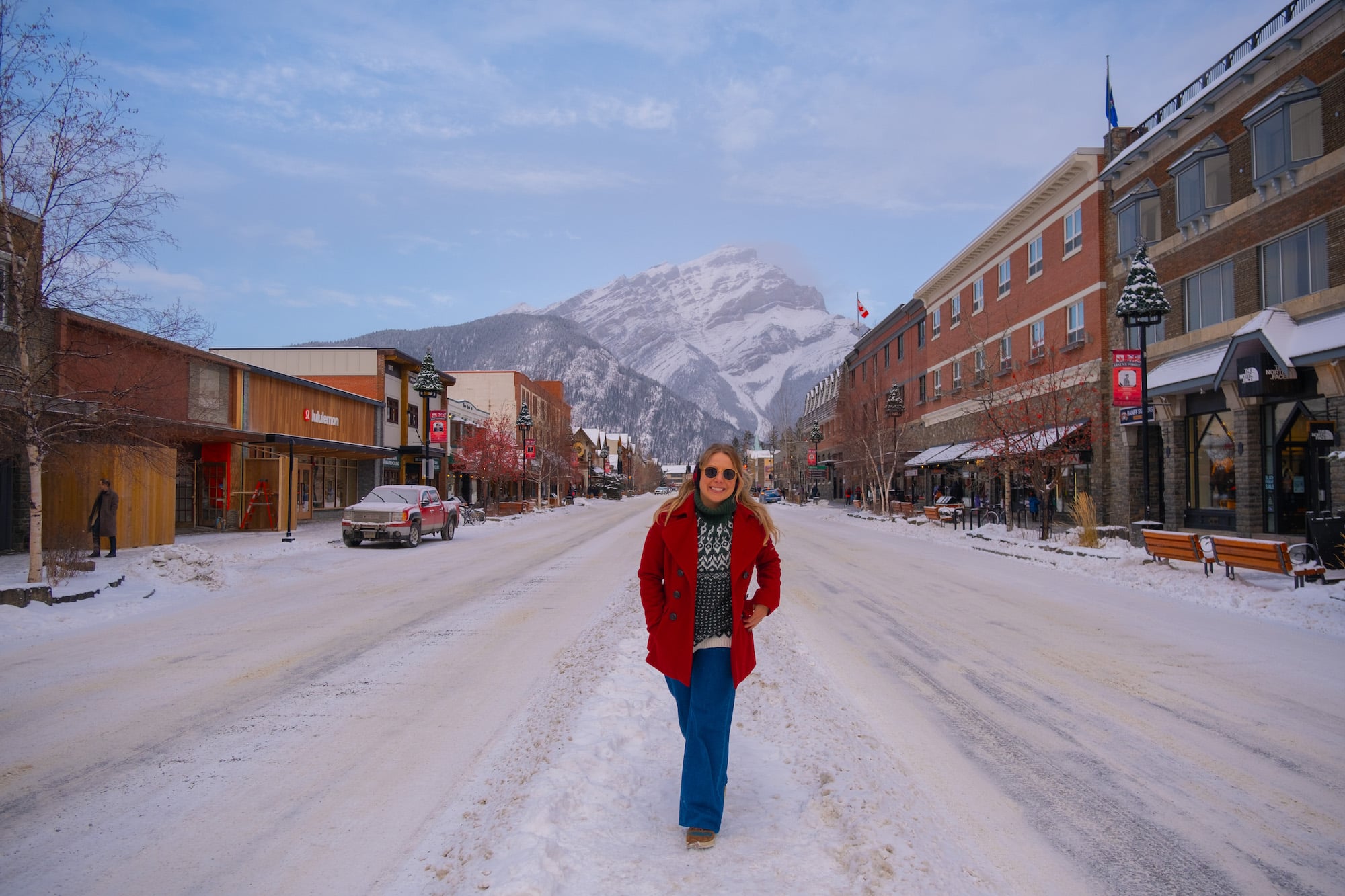
Depending on your Banff itinerary, we lean more toward packing for an active winter holiday than a posh winter holiday. That means technical clothes like down jackets, shells, softshell pants, and thermals. Banff is a small mountain town; locals dress casually or in technical mountain gear. There is no need for trendy jackets, dress shoes, or fur coats here unless that’s your style! Everything is a lot more relaxed than the, say, the European Alps or Aspen.
Winter Temperatures in the Rockies
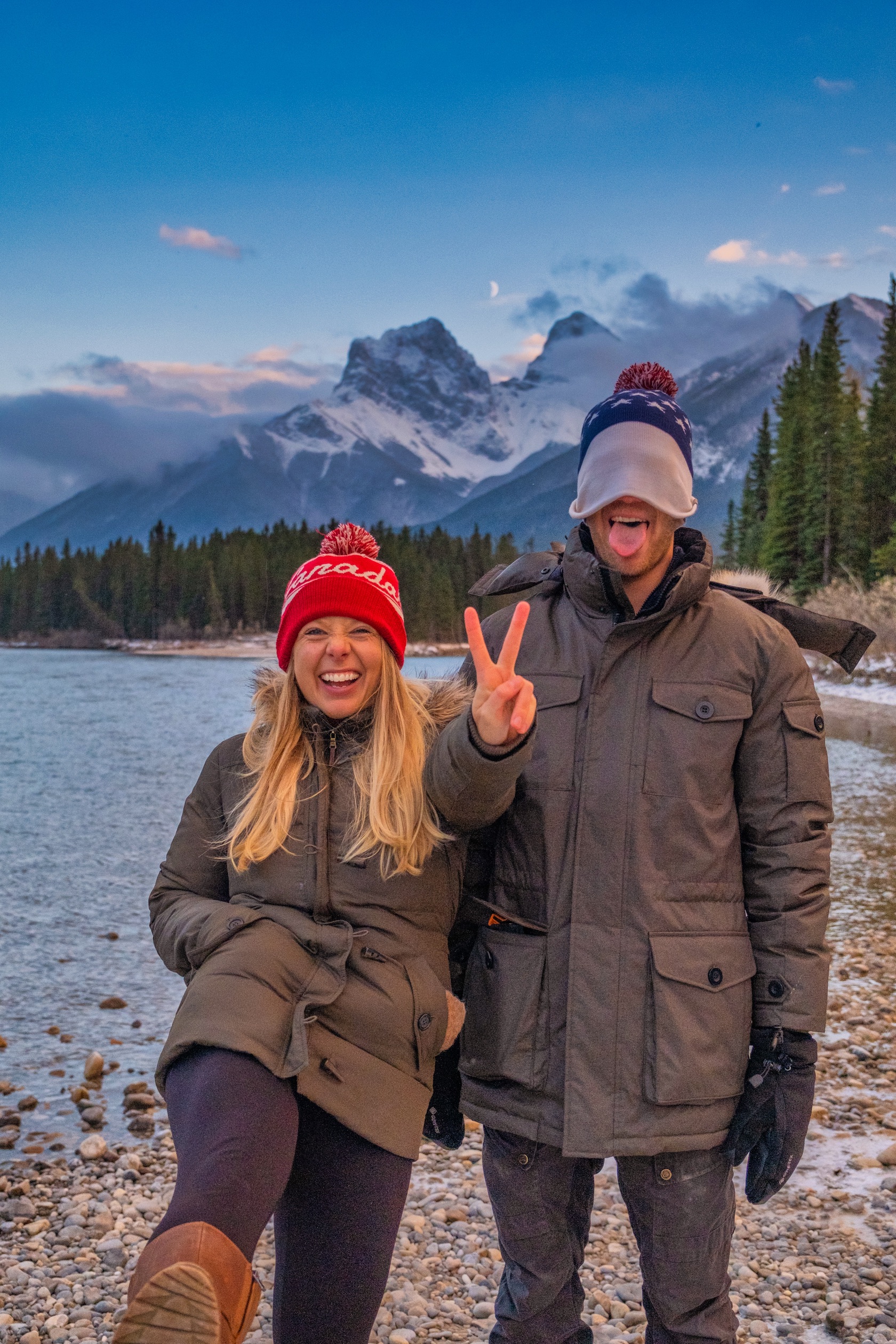
Winter in the Canadian Rockies lasts longer than in most parts of the world, and snow is often on the ground from October to May. Banff is a cold place, and we’ve seen snow every month of the year. Below are the average winter temperatures in Banff to give you a better idea.
As we stated earlier, these are just the averages; however, Banff is notorious for its Chinook winds, which cause wide temperature swings where one day will be a mild 32°F/0°C the next can drop down to a bone-chilling -22°F/-30°C.
Weather is unpredictable much further out than a week or two, so you should pack and plan for freezing cold temperatures in the winter and continue to monitor the weather closer to your trip.
- Banff in November: 33° / 17°F or 1° / -8° C
- Banff in December: 23° / 7°F or -5° / -14°C
- Banff in January: 25° / 7°F or -4° / -14°C
- Banff in February: 32° / 11°F or 0° / -12°C
- Banff in March: 39° / 18°F or 4° / -8°C
What are Chinooks?
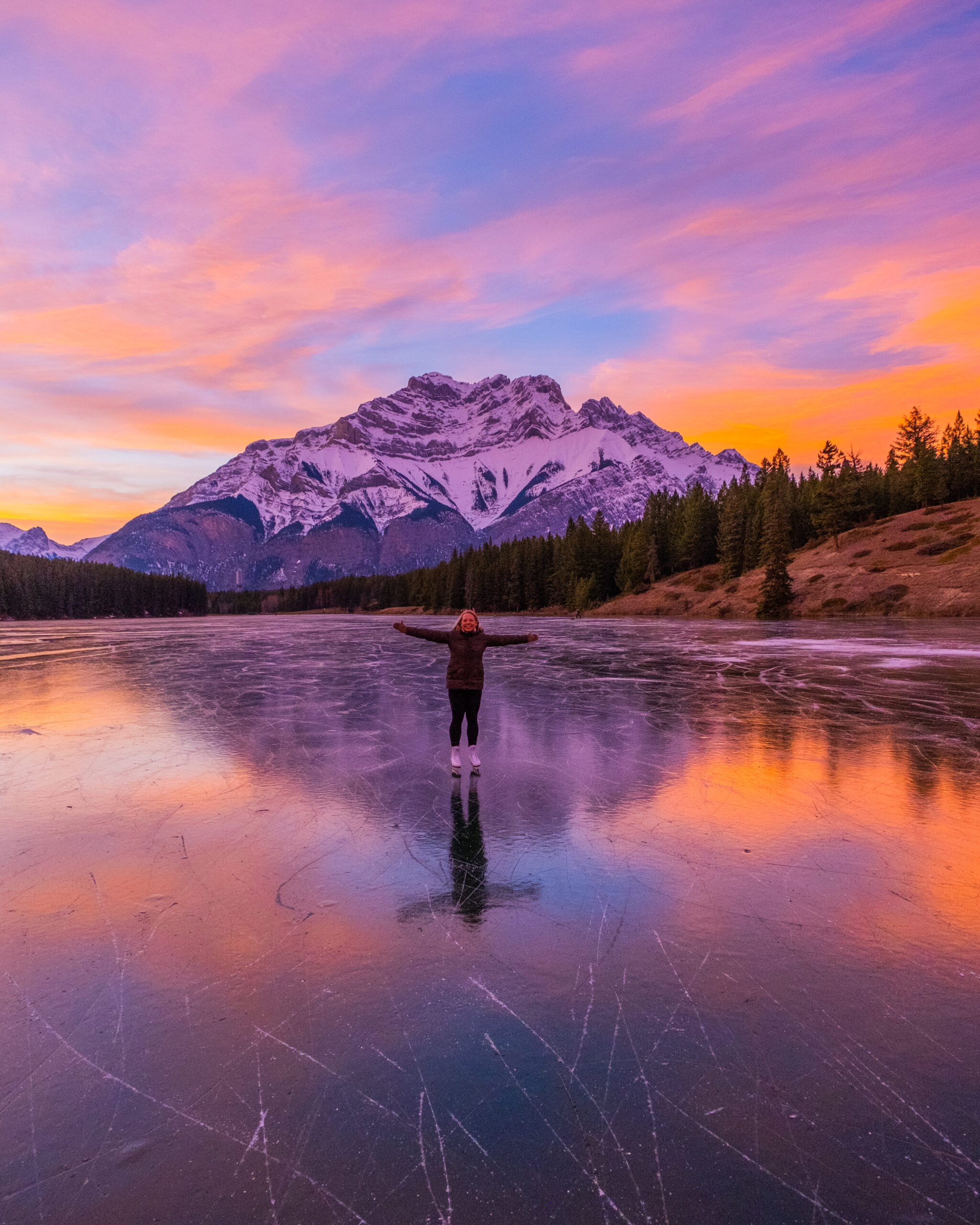
If you’re visiting Alberta in the winter, you should familiarize yourself with Chinook winds or just “Chinooks.” A Chinook is a weather phenomenon in Southern Alberta where warm, dry wind from the Pacific blows eastward over the Rockies after passing through British Columbia. These warm winds can shift the temperature by over 20°C in just one day!
You’ll notice the Chinooks from a rapid change in temperatures and sometimes strong winds that can reach nearly dangerous speeds. However, what I love most about the Chinooks is their ability to create the most beautiful sunrises and sunsets in the Rockies!
What to Wear in Banff in Winter
Winter Parka Down Jacket
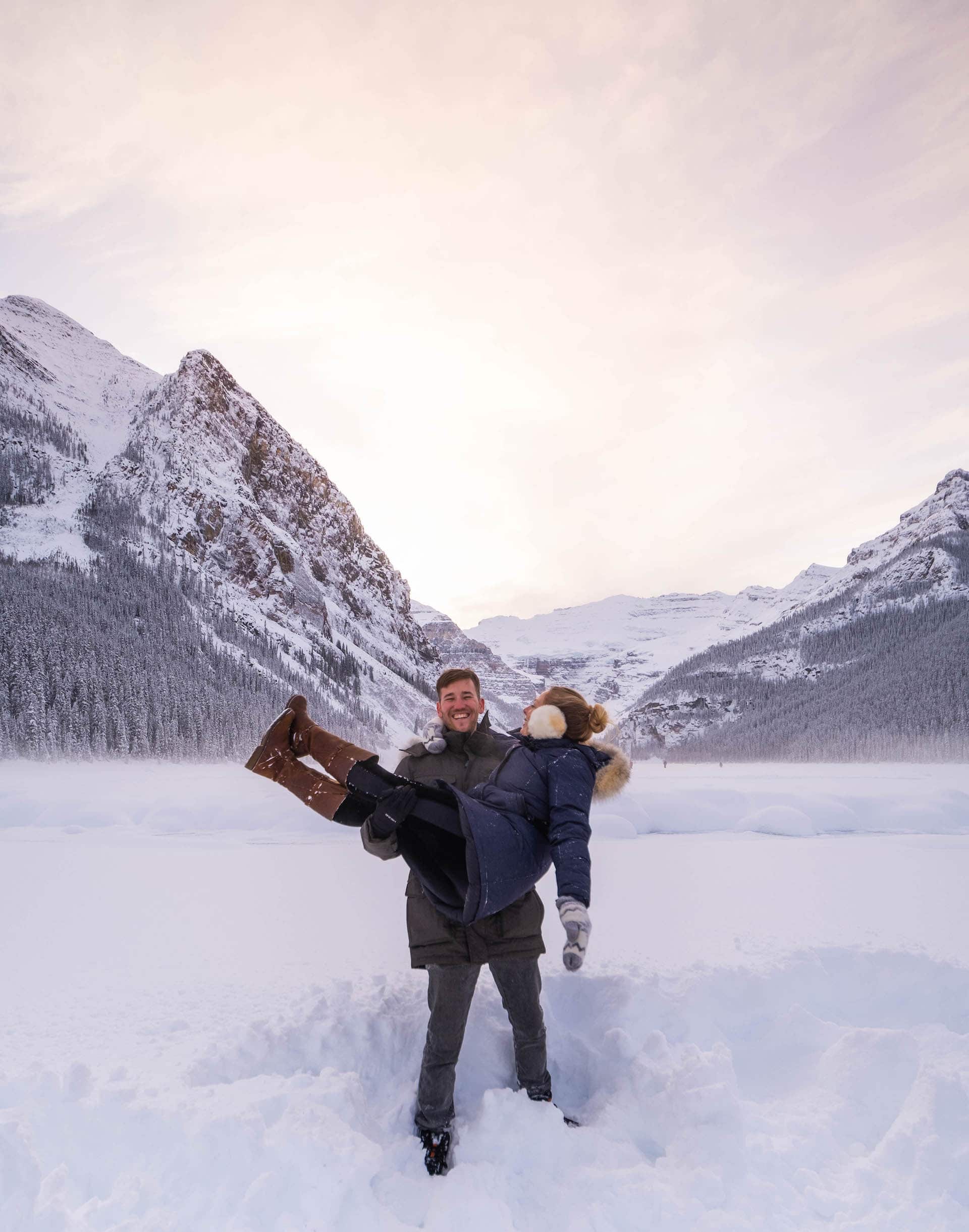
If you have a winter jacket handy, it’s great to pack one. We wear heavy-down parka jackets with hoods for running errands in town or walking around the neighborhood. It’s great for people who come to Banff to pack at least one heavy winter jacket. These are great for sipping hot chocolate at Lake Louise, going on a horse sleigh ride, or even going for a dog sled when you’re not very active.
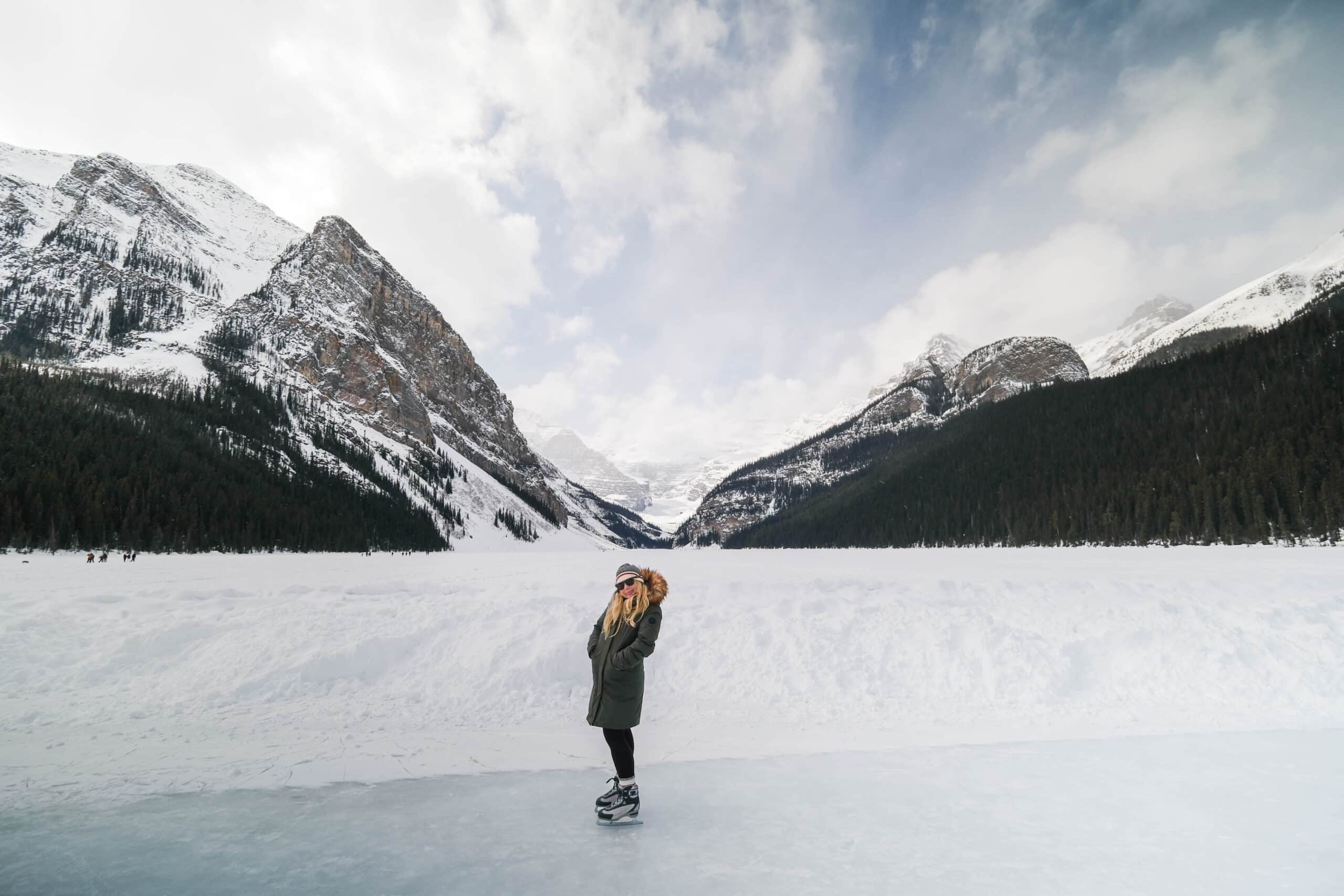
We strongly prefer down jackets as they provide a lot of warmth, but the real key here is a jacket with some weight that will help block the wind and insulate. When we travel with our bulky parkas, we wear them on the plane, as an oversized winter jacket can quickly eat up half your luggage. When we play tourist around town and visit all the popular sights, we love to throw on our big, comfy down parkas. Patagonia makes fantastic winter parkas!
Down Jacket
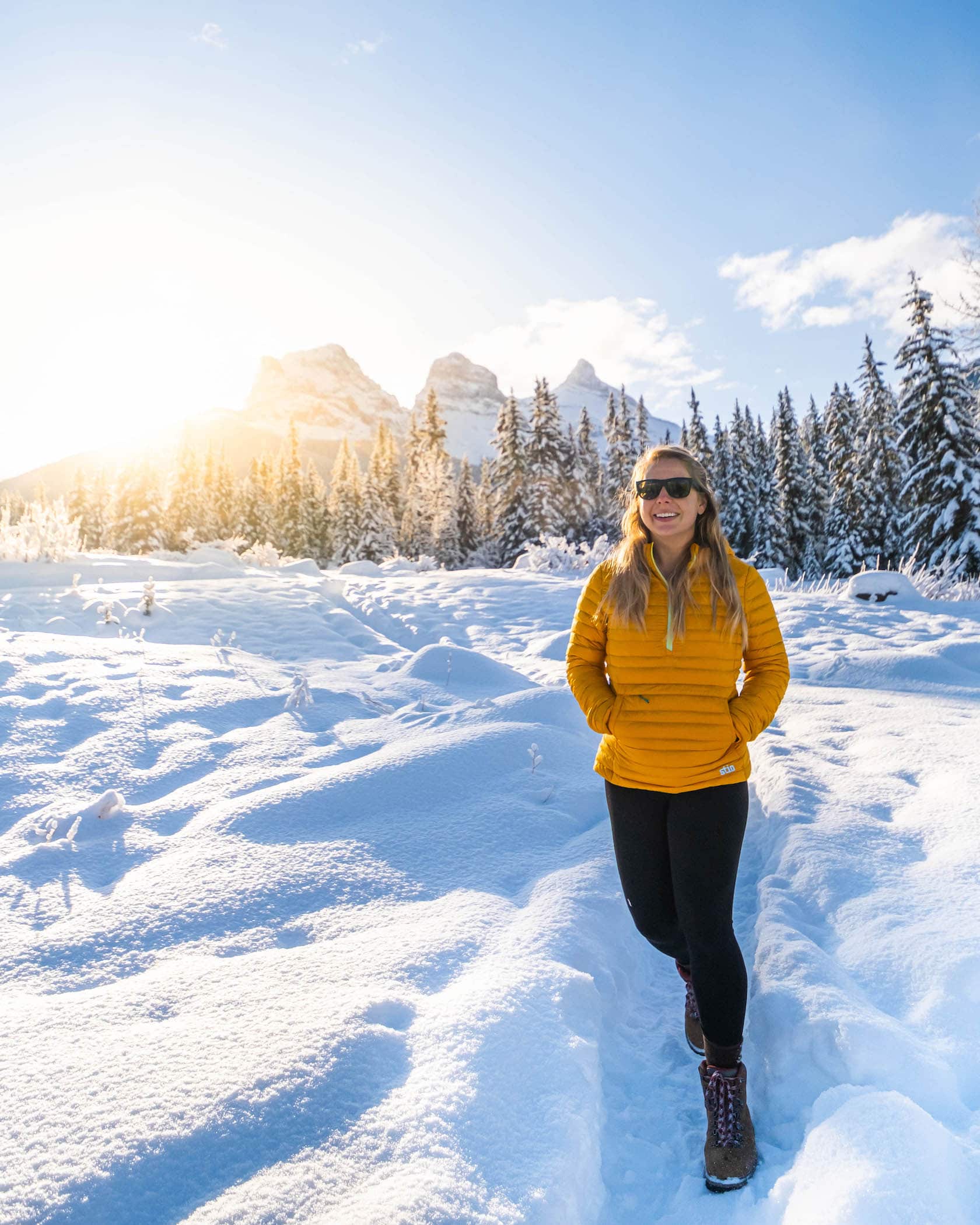
We take a light, packable down jacket on almost every trip and use ours all the time around Banff. It’s a really versatile piece of clothing because it can be packed down and travel in your suitcase. It’s great for mild days in the early season, around October/November, or springtime from March to May.
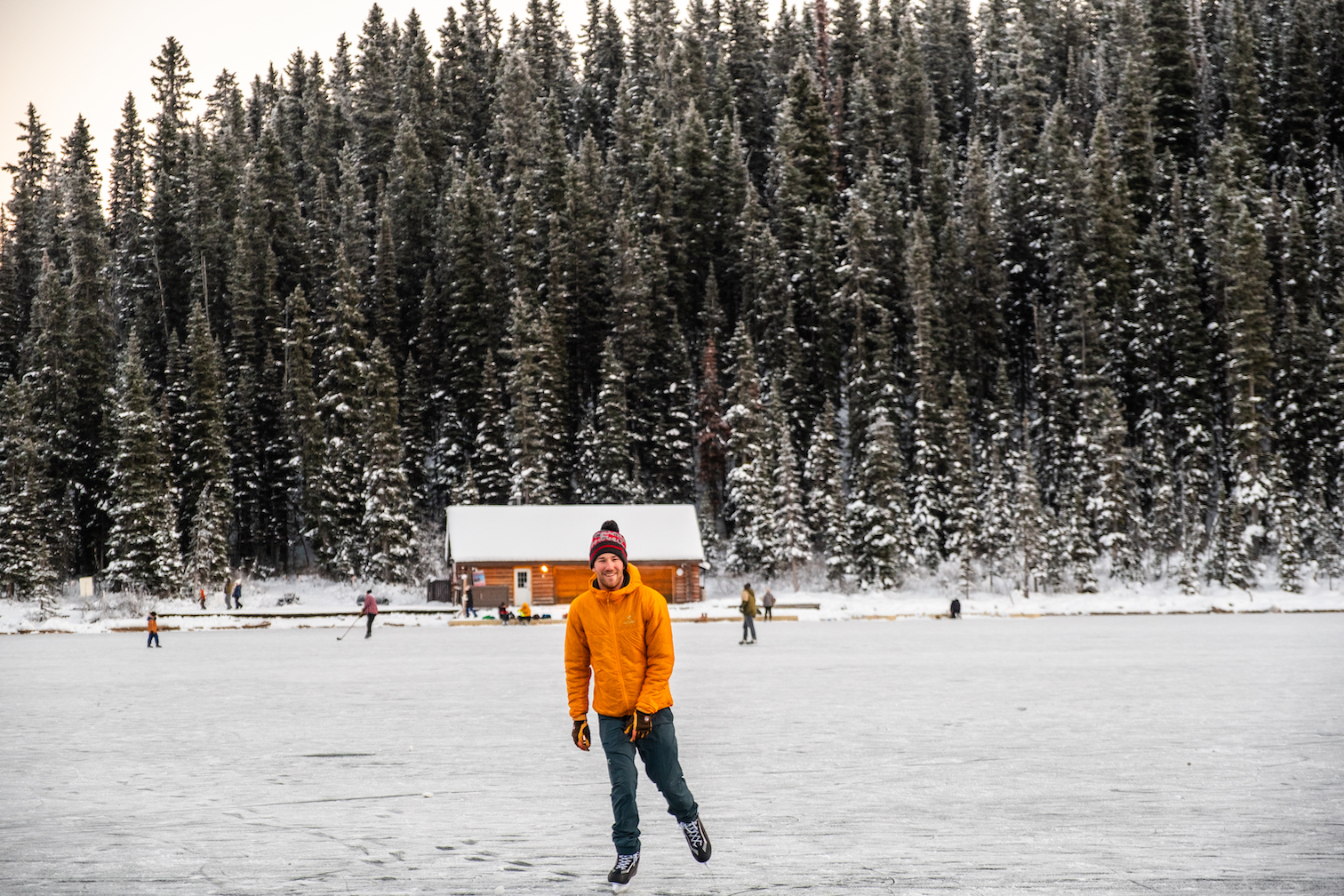
We even wear them in the summer as it’s always down jacket season in the Canadian Rockies. If you’re feeling the chill, a packable down jacket can also be an excellent insulator/mid-layer. That’s also great if you go skiing or snowboarding.
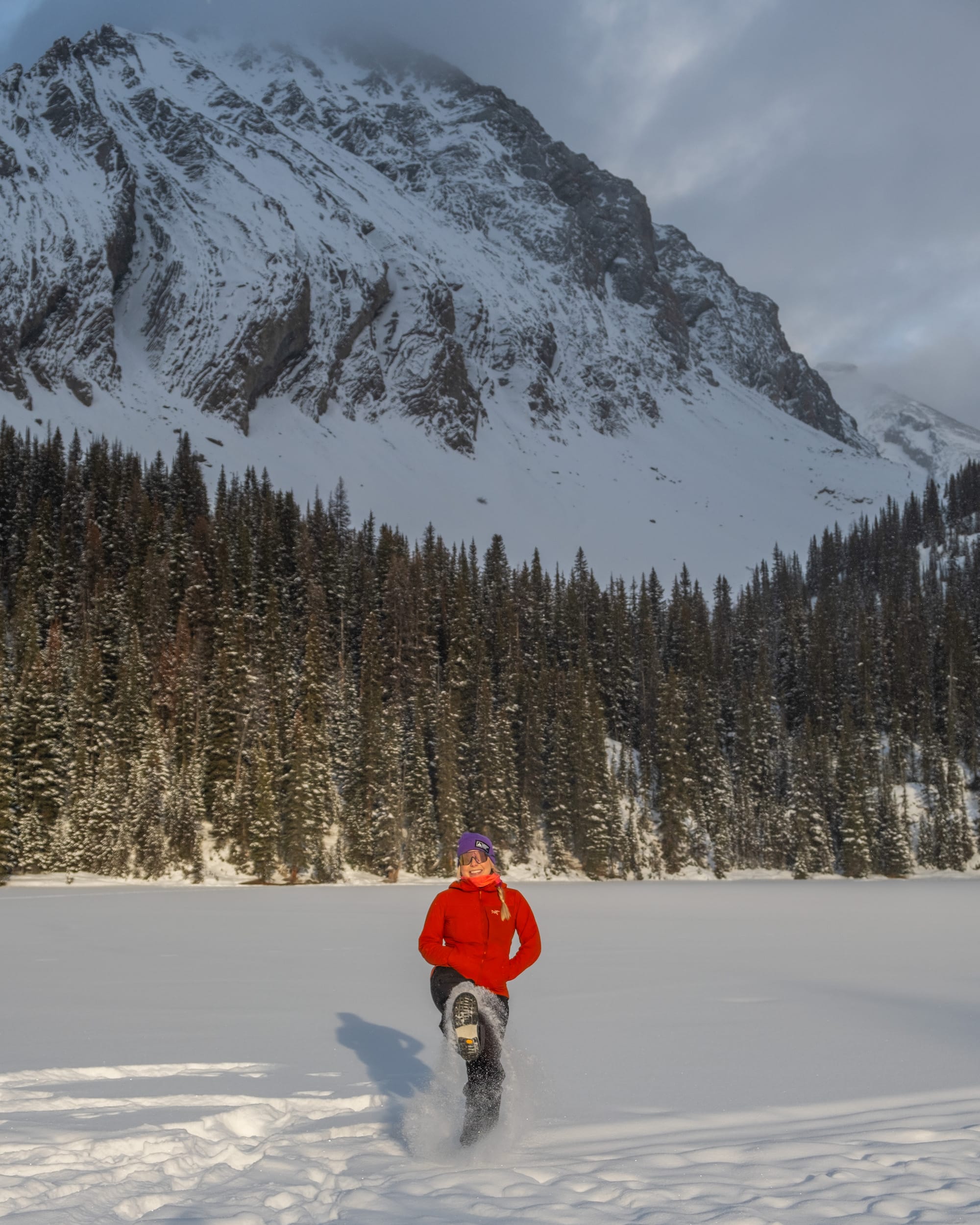
The versatile coat can also be worn for cross-country skiing, ice skating, or snowshoeing. Our favorite down jackets are the Arc’teryx Cerium Hoody and the Arc’teryx Thorium, but when we want something a little lighter we’ll also go with the Arc’teryx Atom.
Fleece
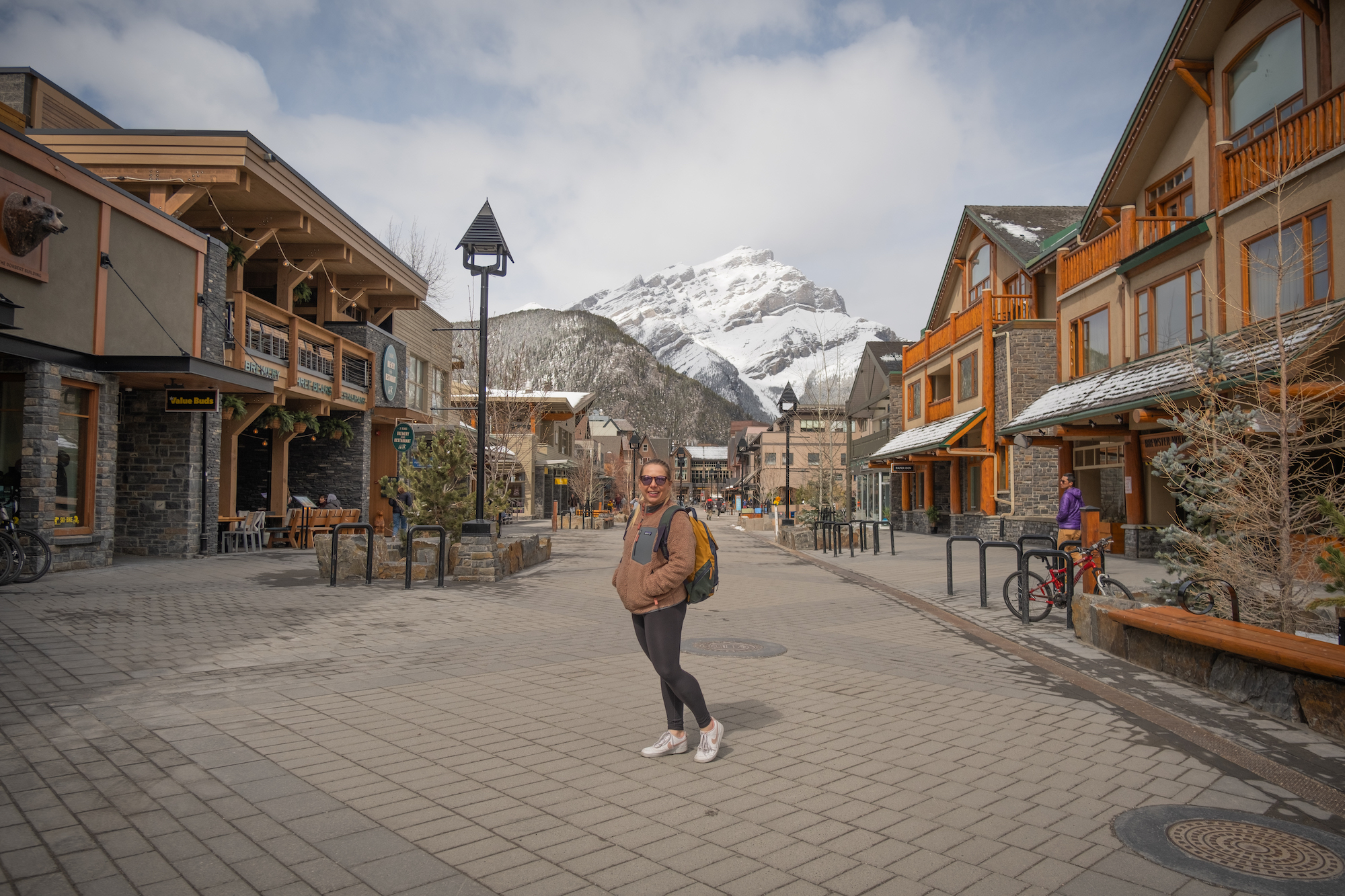
I mean it when I say I LIVE in fleeces throughout the winter. Fleeces are exceptionally great in the shoulder season months of November, April, and May when it’s still chilly outside, but not enough to warrant a full parka.
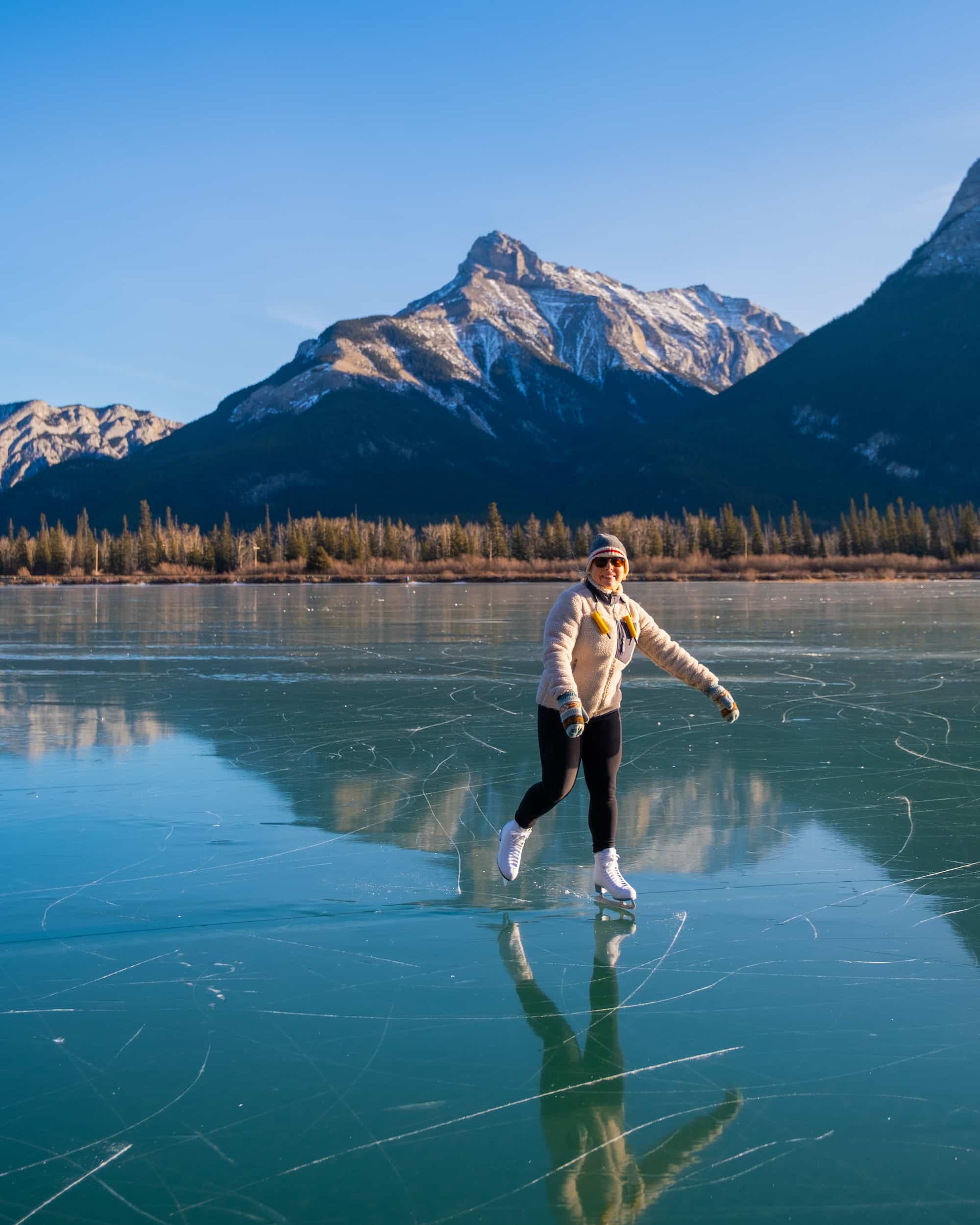
I have multiple Patagonia Retro style fleeces, which are warm enough to wear like a jacket when it’s around 0 degrees. I also love Cotopaxi fleeces which are warm and fuzzy – great for sitting by the fire!
Cute Sweater
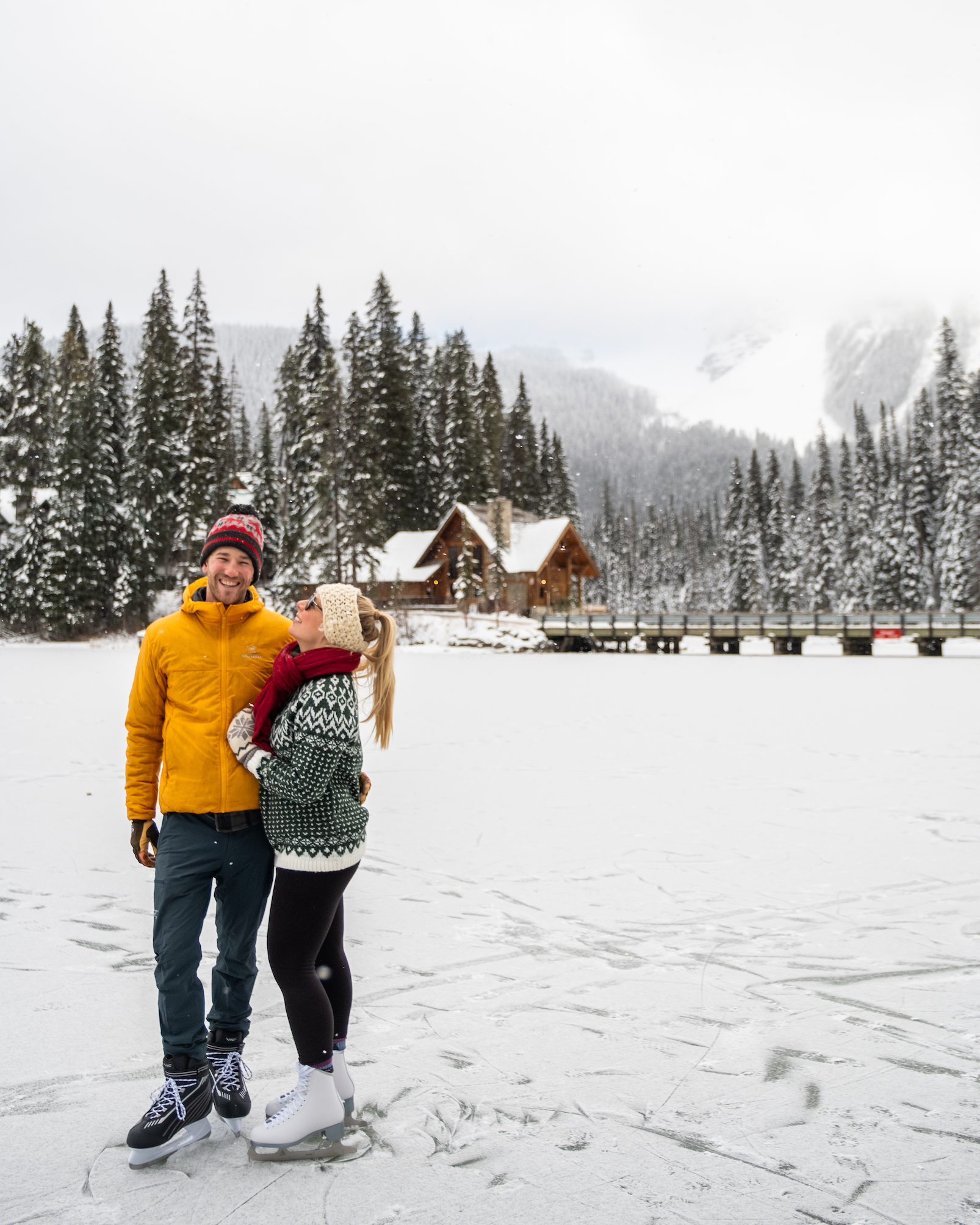
Every visitor should have at least one sweater on their Banff winter packing list! I wear sweaters between October and April and go heavy on them around Christmastime in Banff! Bring one or two, and then look for a few when strolling Banff Avenue – they are everywhere!
Flannel
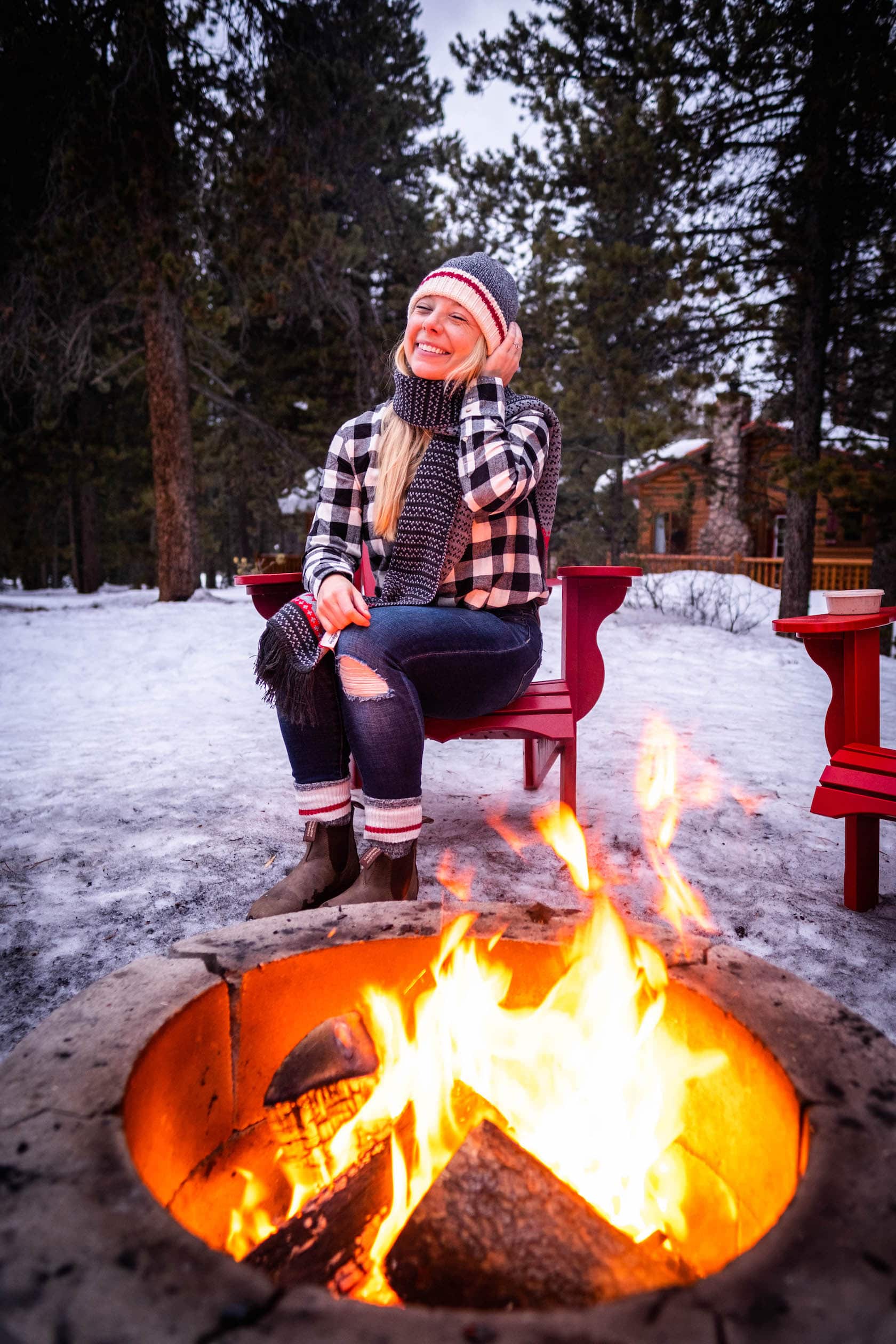
A flannel for men or women is classic in Canada, especially in winter. Flannels here are stylish enough to wear to any dinner at a restaurant or relaxed enough to wear ice skating or hiking. The thick cotton is cozy and provides a lot of warmth.
Casual/Hiking Pants
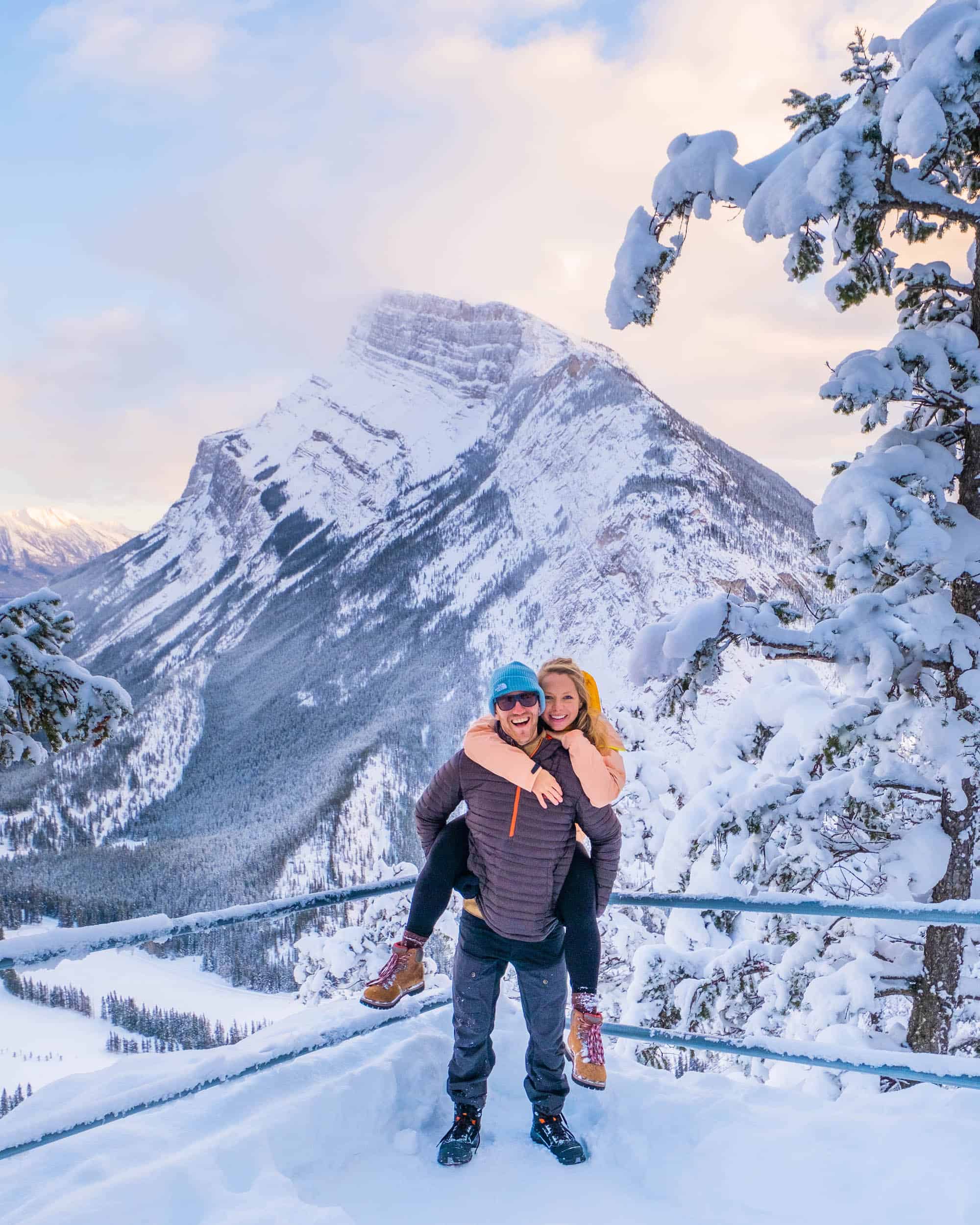
A casual pair of hiking pants for walking around town is great to pair with a sweater or wear during winter activities. If we’re going for an easy hike like climbing up Tunnel Mountain, cross-country skiing, or a snowshoe on a mild day, we rarely wear snow pants and instead use a synthetic pair of pants with thermals underneath.
These pants can vary from basic hiking pants to more technical soft-shell pants. They’re more comfortable and less goofy than bulky snow pants. It’s best to go with whatever synthetic pants you have at home. Ski pants are best reserved for winter activities like tubing, skiing, or dog sledding.
Thermals
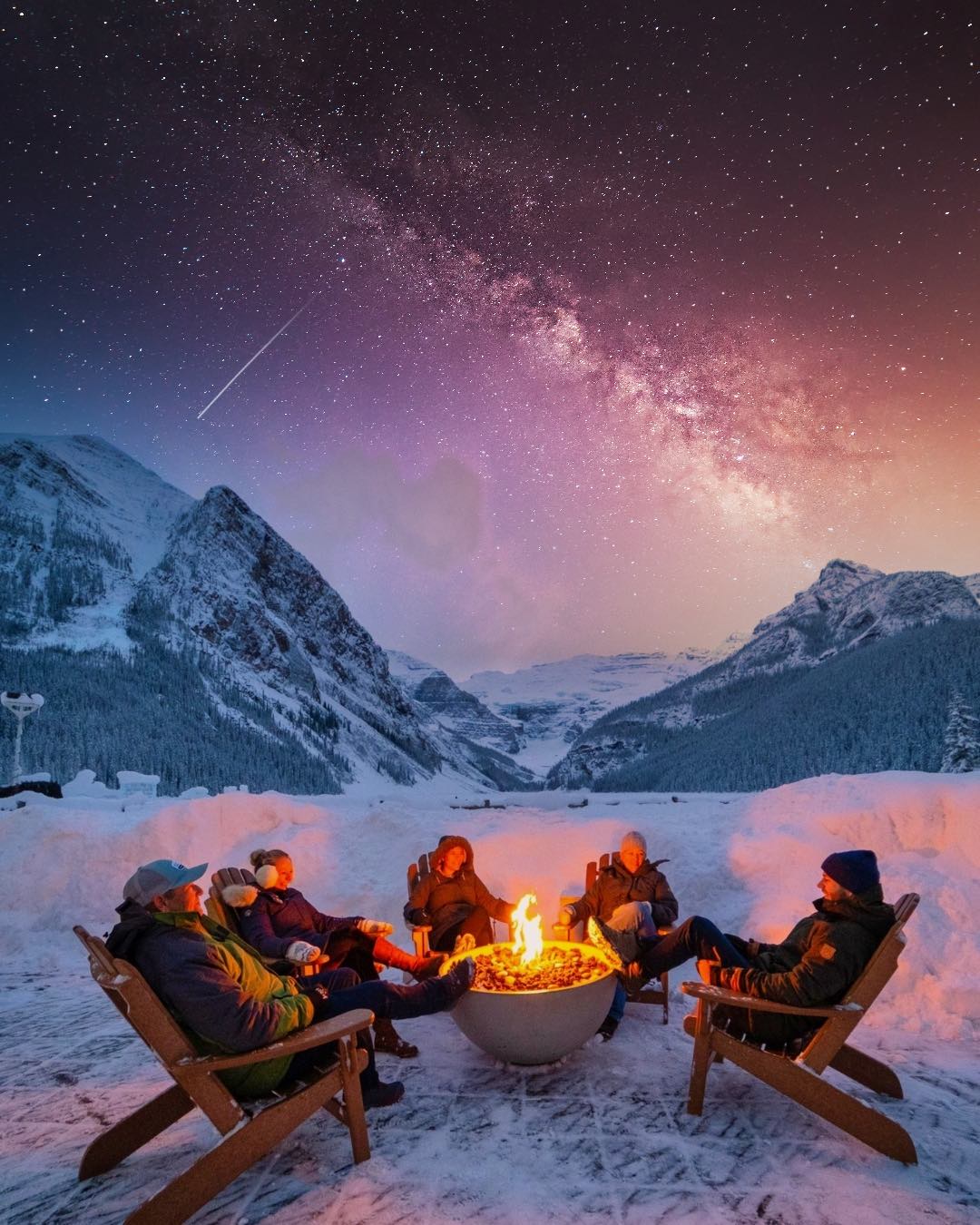
A quality base layer is made from a natural fiber like wool, as it has excellent technical advantages. Wool can resist odor, wick away sweat or snow, and provide warmth. If wool is cost-prohibitive, choose thermals from a polyester or nylon blend.
It’s best not to wear a cotton base layer, as cotton pulls body heat away and remains wet for an extended period. After testing, we’ve found Smartwool and Icebreaker to be two of our favorite wool baselayers. They have tremendous comfort and performance. For a more affordable base layer with plenty of longevity, we love the synthetic base layers from Helly Hansen.
Base layers for your legs are great for walking around the town or for any winter activity you may enjoy. You don’t want to wear your ski pants to the bar, but jeans may be too cold. However, if you slip on a pair of thermals underneath, it makes life a lot warmer. Note size charts, as top and bottom sizes can be different when purchasing. Consider your base layers one of the top priorities when packing for Banff in the winter.
Fleece Lined Leggings
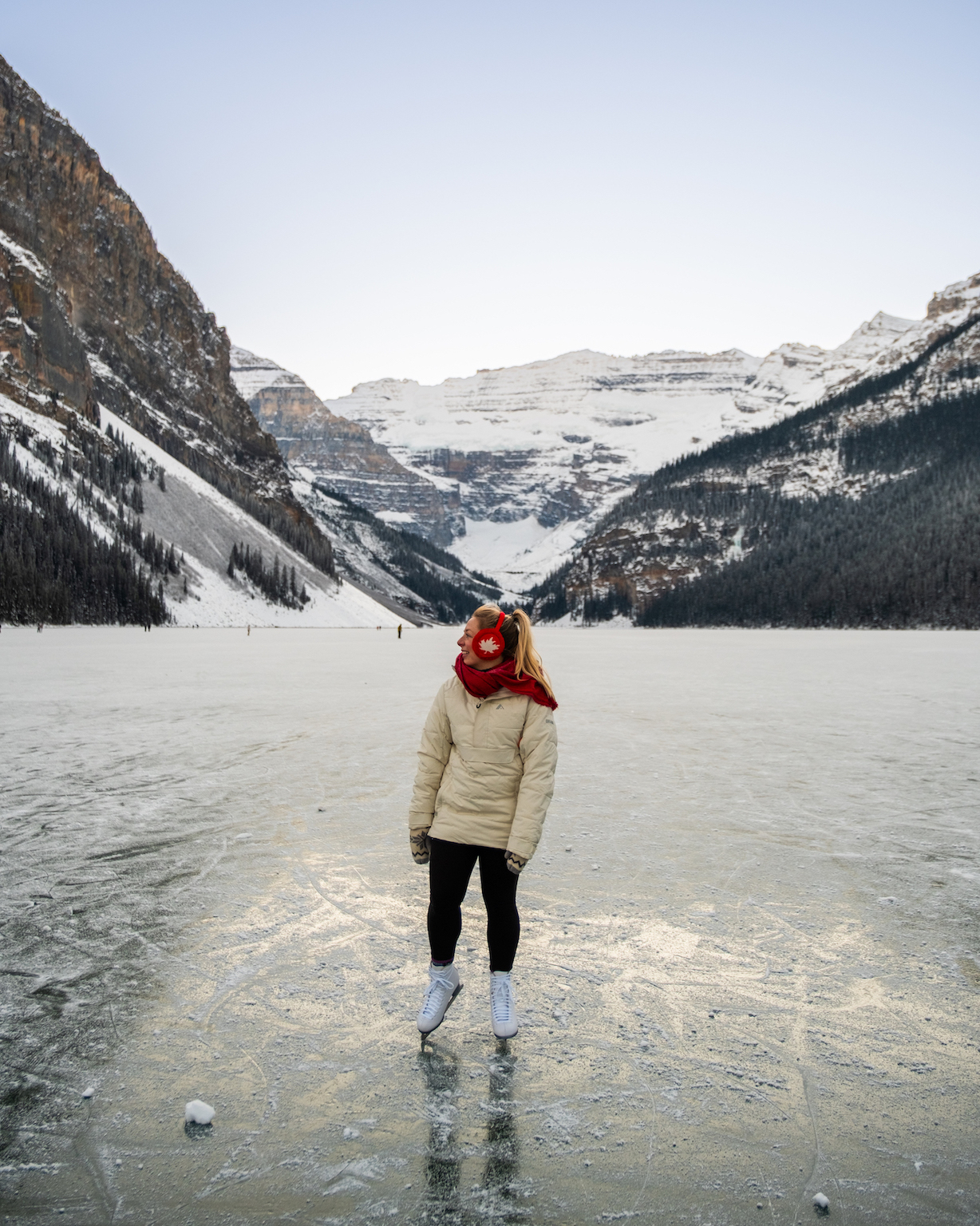
Any woman traveling to a cold destination should have a pair of these. One of my favorite items in the winter is fleece-lined leggings. Regular leggings are far too cold for me to wear here in the winter, but a good pair lined with fuzzy fleece on the inside? I have numerous pairs from Amazon!
Wools Socks
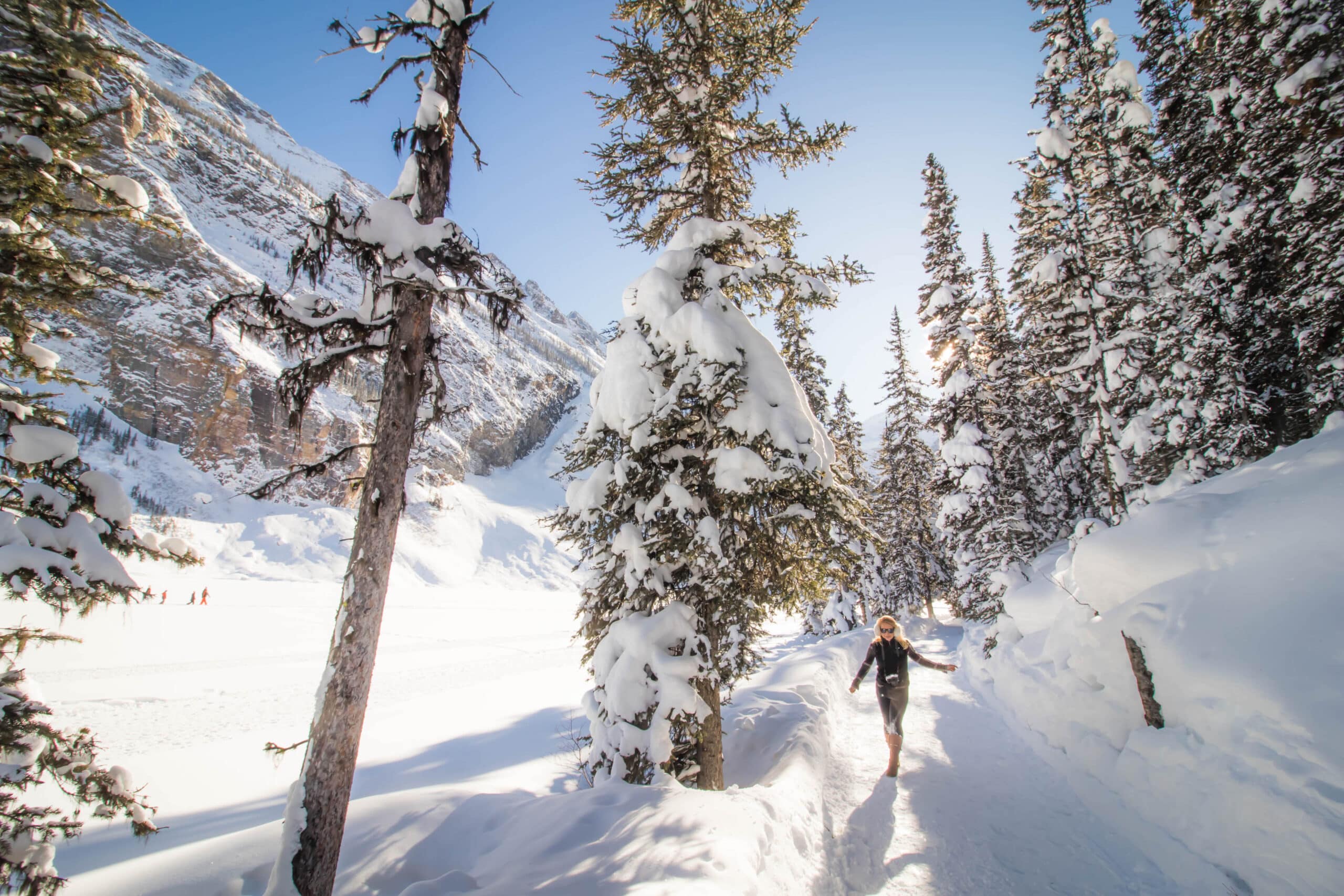
For any trip in the winter, it’s a good idea to pack a few wool socks for your days out exploring or skiing. Opt for a material such as wool or synthetic for your socks, like thermals. Do not wear cotton socks when doing any activities out in the snow, like snowshoeing, hiking, or skiing, as they will almost certainly lead to cold feet. For most, any wool or warm synthetic socks will do the job.
However, if you plan to ski, it’s a good idea to try out some ski-specific wool socks as they have attractive features. Opt for a medium or slim sock. Loose or bulky socks can trap moisture and bunch up, which results in cold feet. On that note, do not wear two pairs of socks, as they will also trap moisture. The key to warm feet is dry feet! The last thing we put on before heading out the door are our socks, don’t wear them in a hotel bathroom! Almost all our socks are from Darn Tough, they have the cutest graphics!
Winter Boots
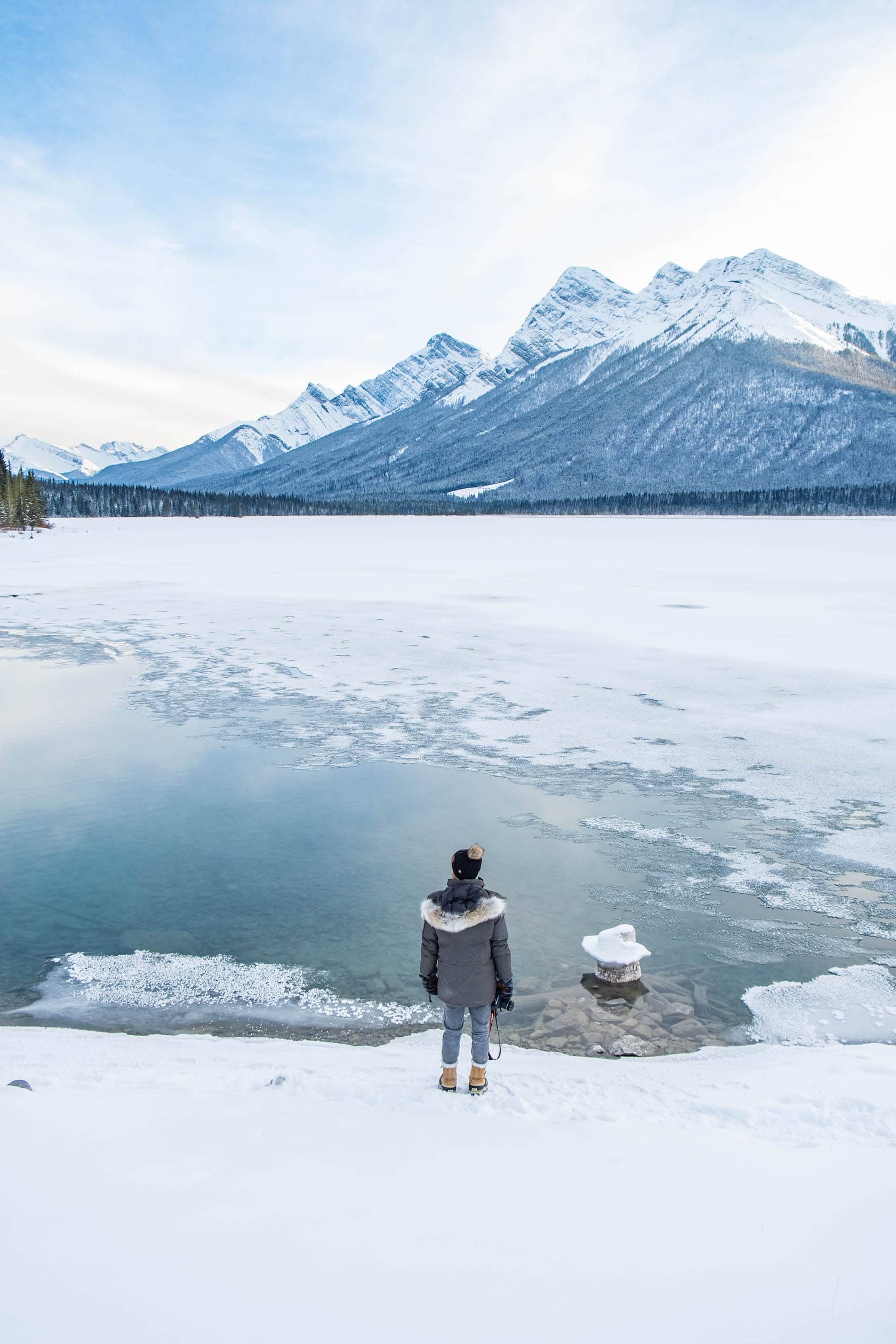
You aren’t going to want to trudge around town in a pair of sneakers during your whole trip. Pick up a pair of functional but stylish boots with a high ankle to prevent snow. We have a pair of Sorel boots for deep snow days in Banff. However, most winter snow depths aren’t bad in town, so sturdy boots will work perfectly.
Casual Gloves or Mitts
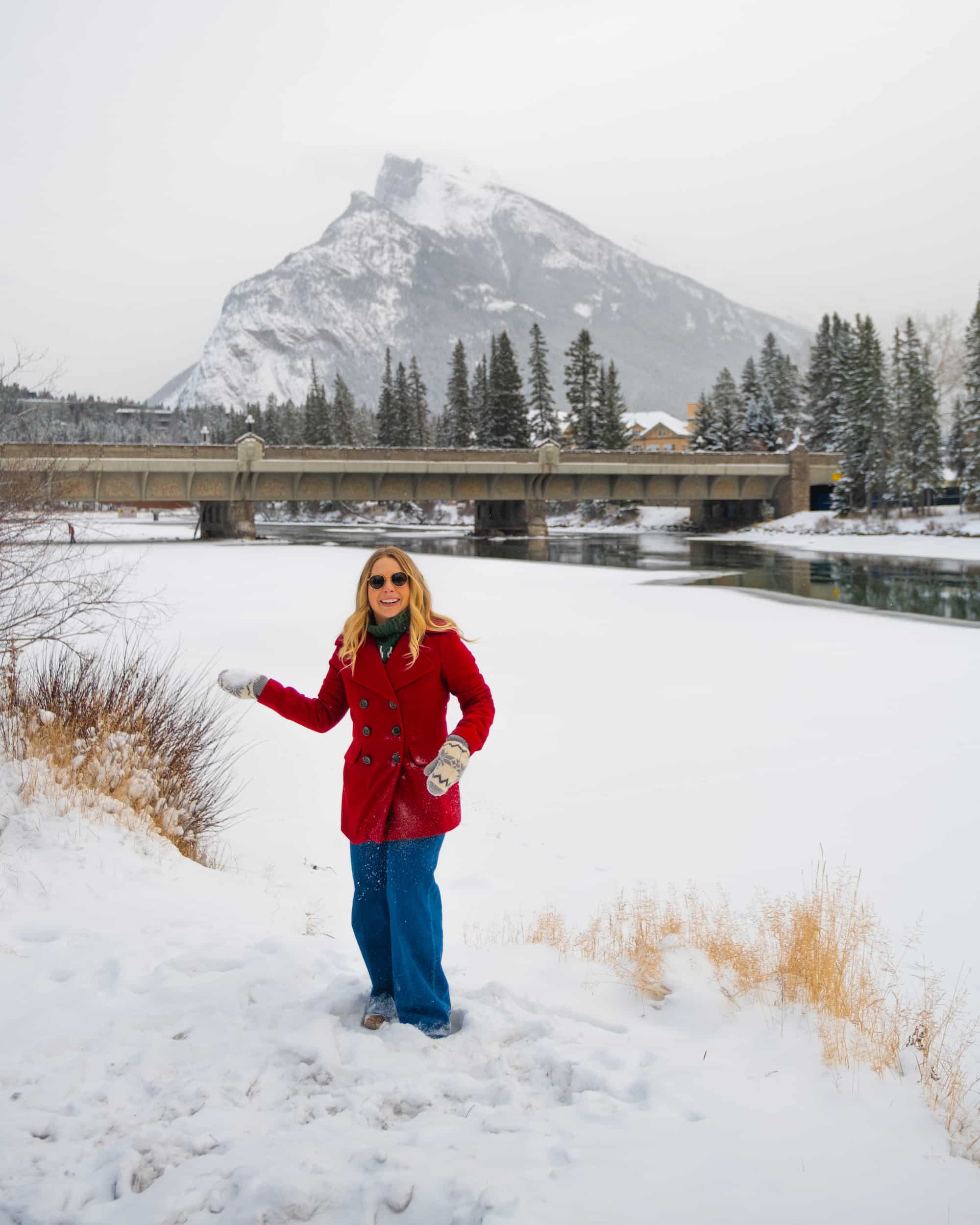
I suggest bringing at least one pair of casual gloves or mittens for walking around. I personally like the ones that have touchscreen fingertips. It’s also common for many ski-specific mittens and gloves to come with liners that work well for casual use around town. If you really want to go big, you can get these cute Canada mitts for your first trip to the Great White North!
Toque or Beanie
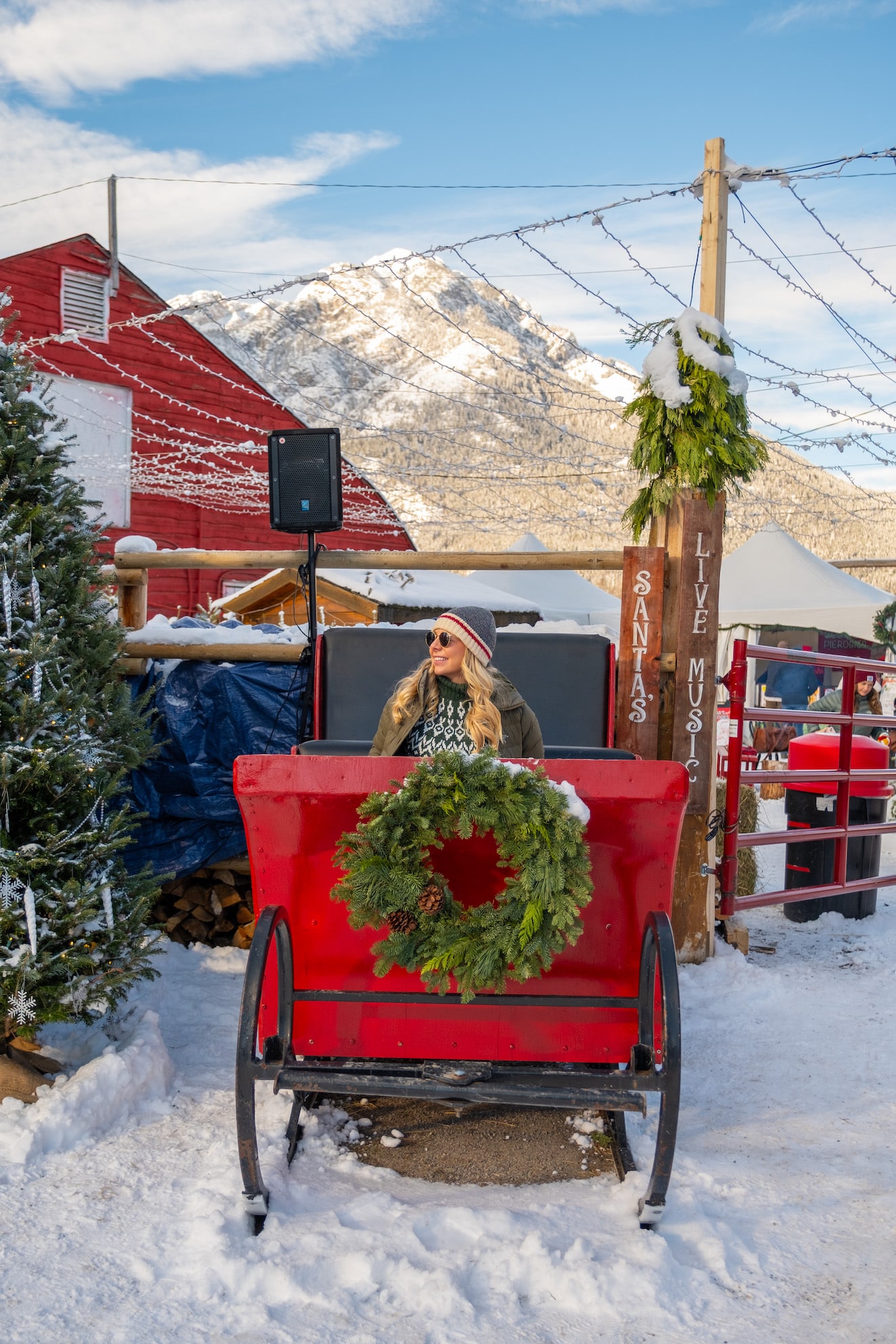
You’ll definitely want a way to protect your ears and head from the cold. A hat is one of the best ways to retain body heat. We just got some hats from Toques From The Heart, which makes some tremendously comfortable, warm, and excellent quality hats. The best part is the company gives away a toque to a Canadian in need with the sale of every hat.
Microspikes
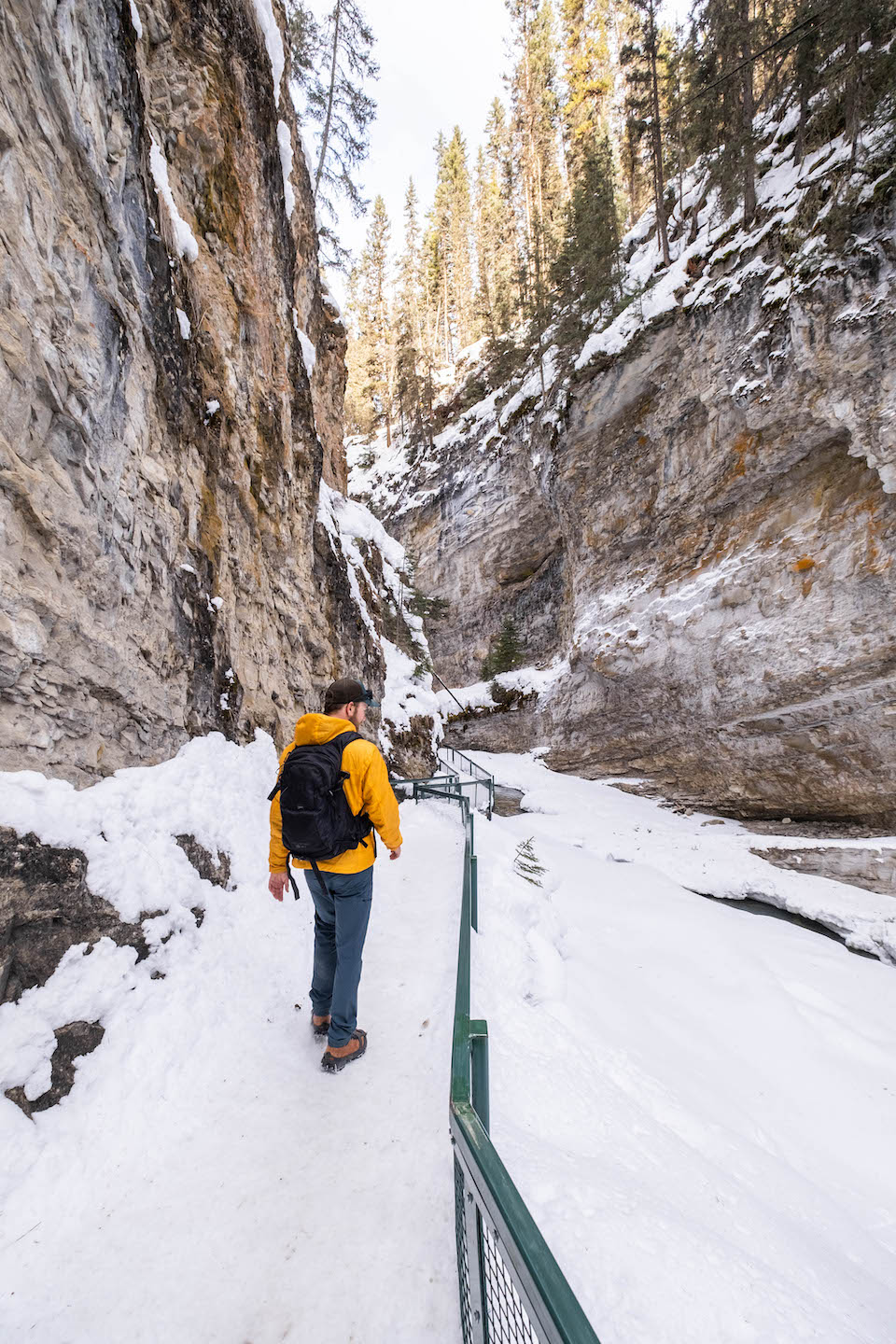
Microspikes are a cheap investment that will come in handy if you plan on doing any winter hiking. They are especially helpful if you have plans to hike Johnston Canyon, which is a very icy trail.
You can purchase microspikes on Amazon before your trip (just make sure to keep them in your checked luggage). Alternatively, you can buy them at any Canadian Tire when you get to Alberta. Lastly, if you don’t want to purchase them Snowtips Bactrax in downtown Banff rents them out for about $15.
What To Wear For Sports & Skiing
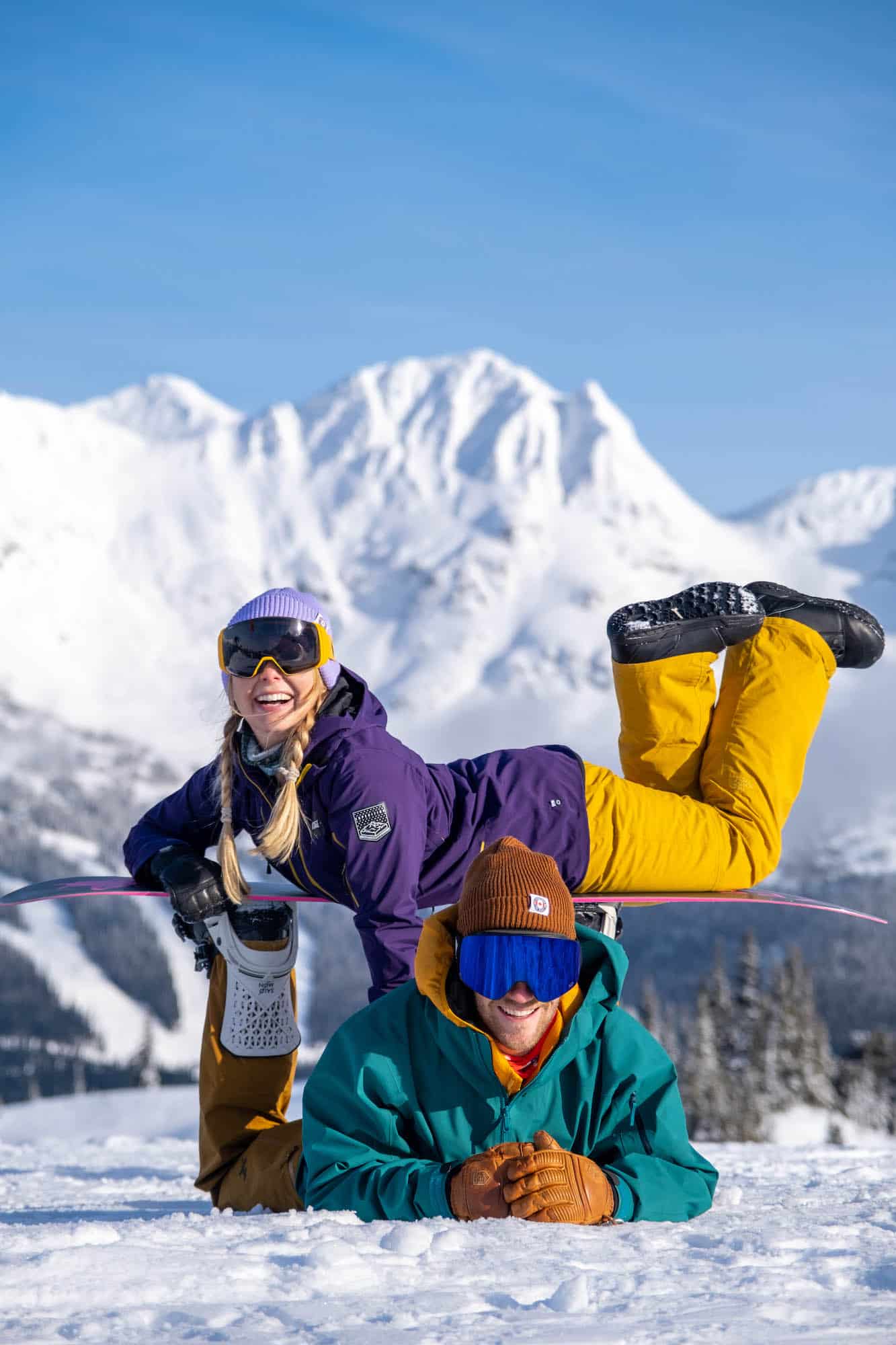
This is a general overview of what to pack for a trip to Banff for skiing. These items are also good for many winter activities you can enjoy around Banff, like skating, snowshoeing, dog sledding, or ice climbing. If you want a more technical overview of what to wear skiing or snowboarding, check out our post that covers more detail.
We recommend expert riders, skiers, mountaineers, and ice climbers utilize a shell system. However, they likely don’t need our recommendations for shell gear—it’s Arc’teryx if anyone’s curious. Most casual skiers and riders do not need to invest in $2,000 outfits, so we recommend more value-packed insulated jackets for visitors.
Insulated Jacket
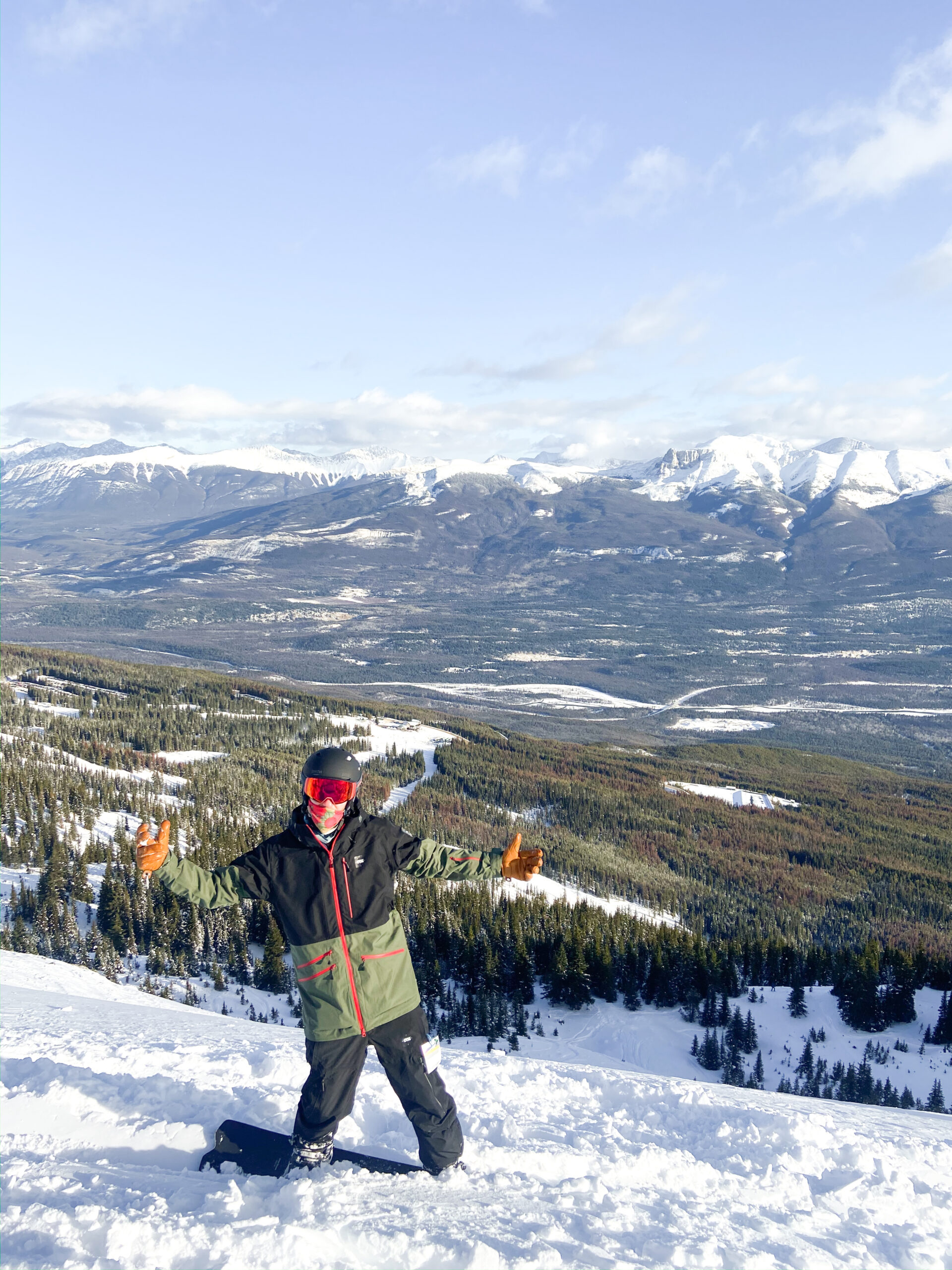
A jacket is the most critical item to pack for a ski trip. A lightly insulated jacket with a waterproof shell and snow skirt is best for most skiers and riders. We ride with a shell jacket for our resort wear jacket that contains light insulation from Picture Organic Clothing. It has many sweet features, such as wrist gaiters, a snow skirt, and a helmet-compatible hood. The Bio-Sourced exterior shell on the jacket has performed beautifully and kept us dry on deep days in Jackson Hole, WY, and Snowbird, UT.
Another great option is a Columbia Interchange Jacket, which provides excellent value. Granted, it doesn’t have any of the performance or sustainable cred like Picture. We are big fans of Columbia due to its accessibility and reliable products. As a side note, every ski jacket should be helmet-compatible and have a snow skirt as a minimum. If it’s your first time, don’t purchase a new jacket. Wear your best winter jacket and accept you’ll probably get some snow down your pants.
Mid-Layer
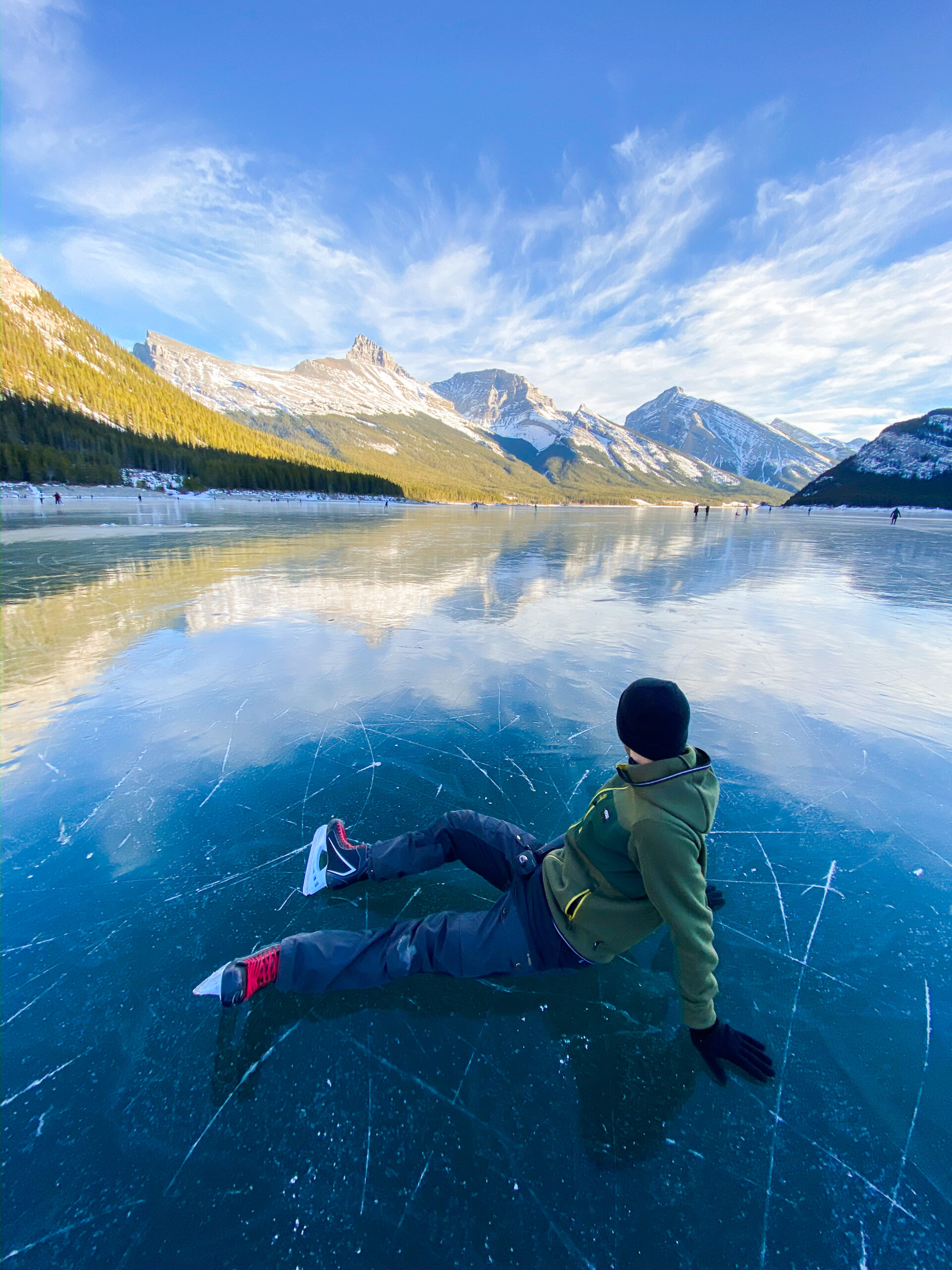
If you opt for a layering system, a mid-layer jacket is where you’ll get most of your warmth. Mid-layers go on over your thermals and operate as a jacket for when you’re not skiing or snowboarding. Even if you’re not skiing, it’s a good idea to pack a good mid-layer for versatility. These jackets come in various fashions, and we have several types for different conditions.
Down jackets provide excellent warmth in dry conditions but are expensive and lose insulation when wet. Synthetic down jackets provide slightly less heat than traditional down but can handle wet conditions well. The most affordable option is a fleece jacket, which offers plenty of warmth at an affordable price.
It’s not technical enough for extreme conditions, but the average person shouldn’t be in adverse conditions anyway. We both use synthetic down jackets from Arc’teryx as our mid-layers. The jackets are versatile and lightweight, provide excellent warmth, and handle moisture exceptionally.
What Ski Pants to Wear?
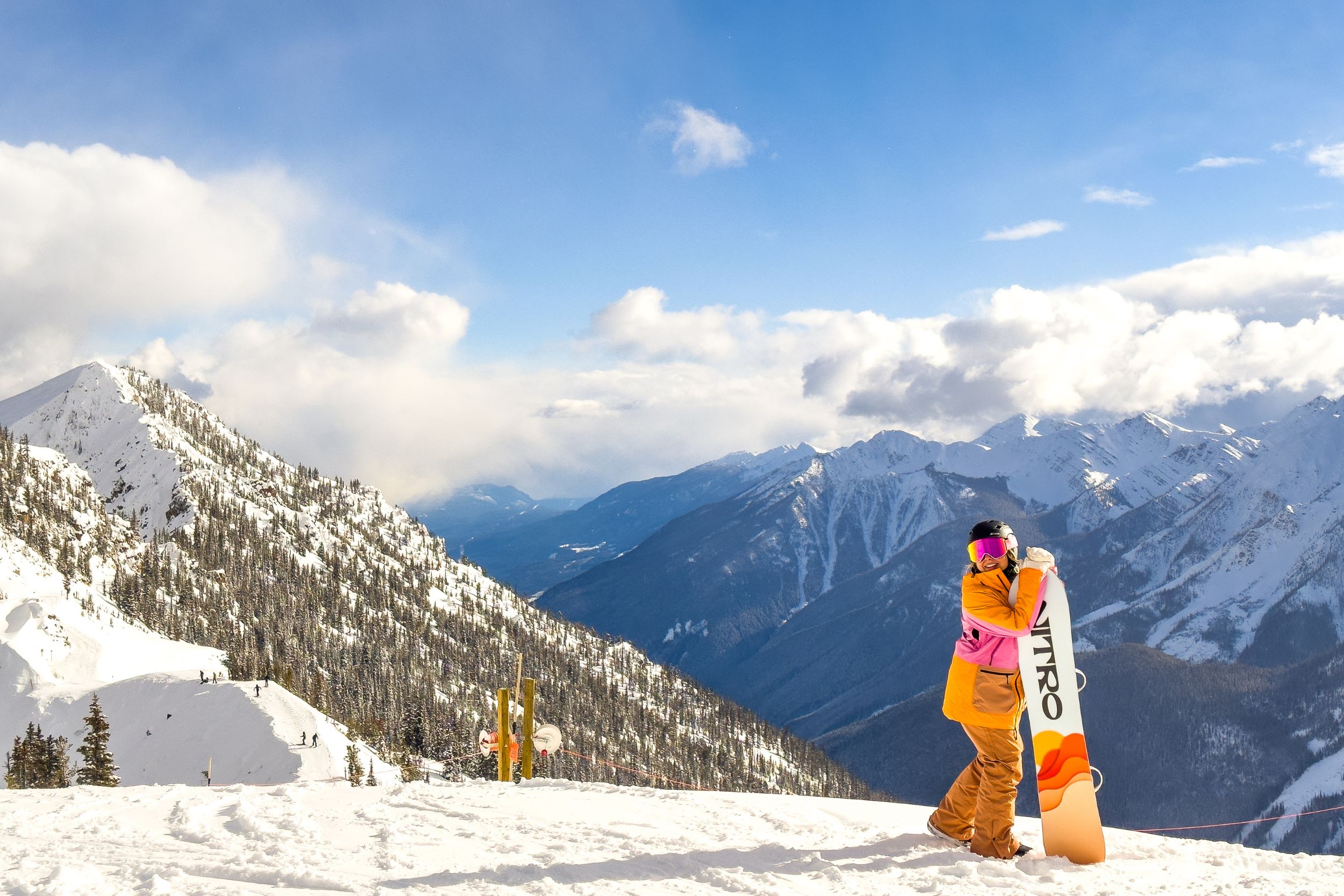
There are three basic styles of pants to wear hardshell skiing pants, bibs, and insulated pants. Hardshell pants tend to fetch the highest price tag and offer the most significant technical capabilities but provide little to no insulation.
Bibs come in shell and insulated versions and offer the most outstanding protection from snow. However, they are more expensive than pants and can be too warm for mild ski days. Insulated pants are friendly and generally the most affordable as entry-level pants. The insulation can make these pants the most restrictive or hot on a mild day.
We would advise that you need much less insulation in the legs than you would think. It’s not your core, and it’s where most of your movement comes from when you ski. Everyone’s body is different, so you should dress for what’s comfortable.
Mitts or Gloves
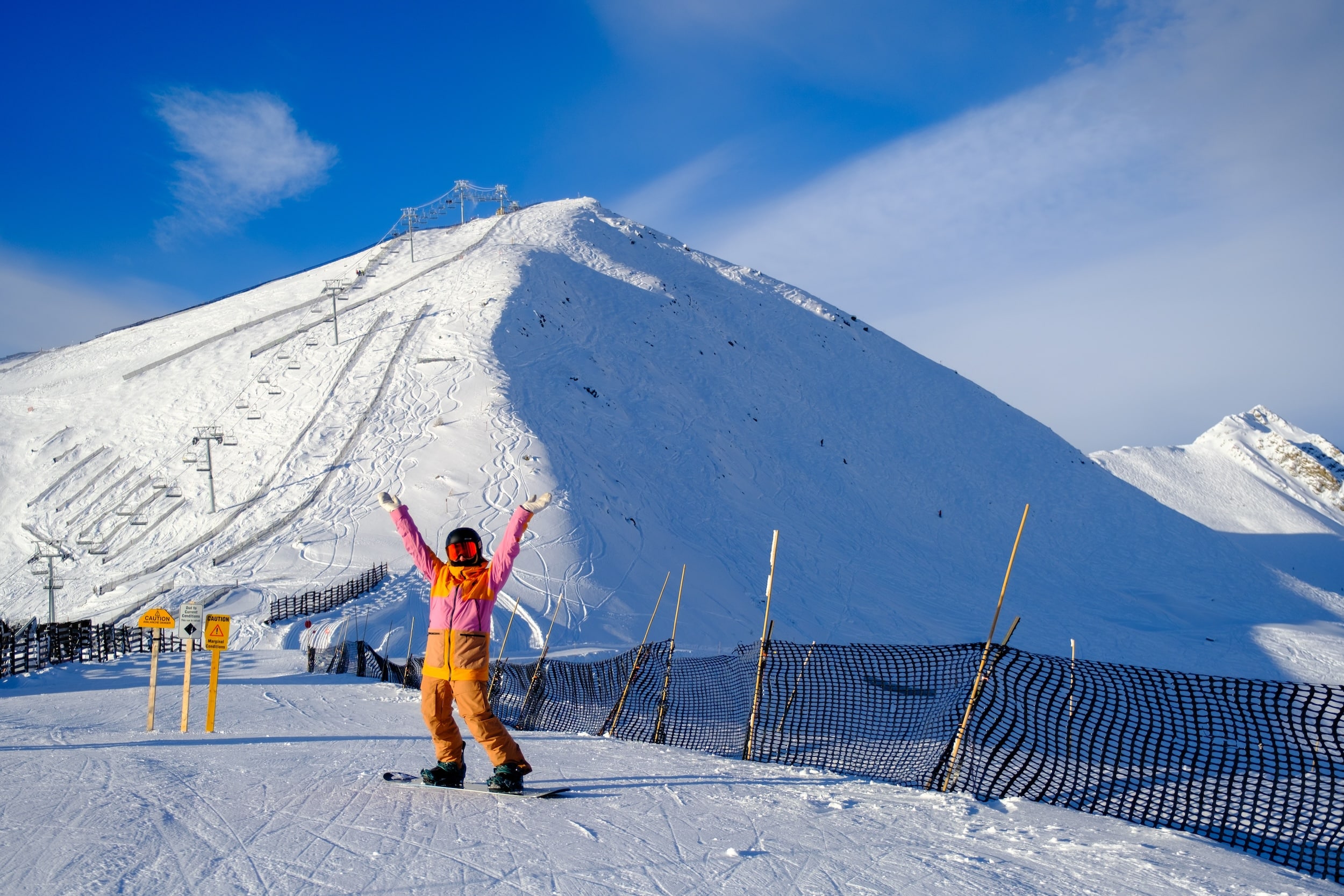
Quality gloves will be your best friend on the slopes because no one likes it when they can’t feel their hands. Seriously, people don’t enjoy winter sports mainly when they get cold. We prefer mittens as they keep your fingers together and allow for less surface area to the cold. This means your hands stay warmer in mitts than gloves.
That being said this comes from two snowboarders. Many skiers prefer glovers to separate their fingers more easily when dealing with their ski poles. It’s all personal preference, but if you’re prone to a chill, I’d suggest some mitts. And at the end of the day, gloves are one of the last things you want to forget about for your winter holiday. All of our gloves come from Hestra.
Balaclava
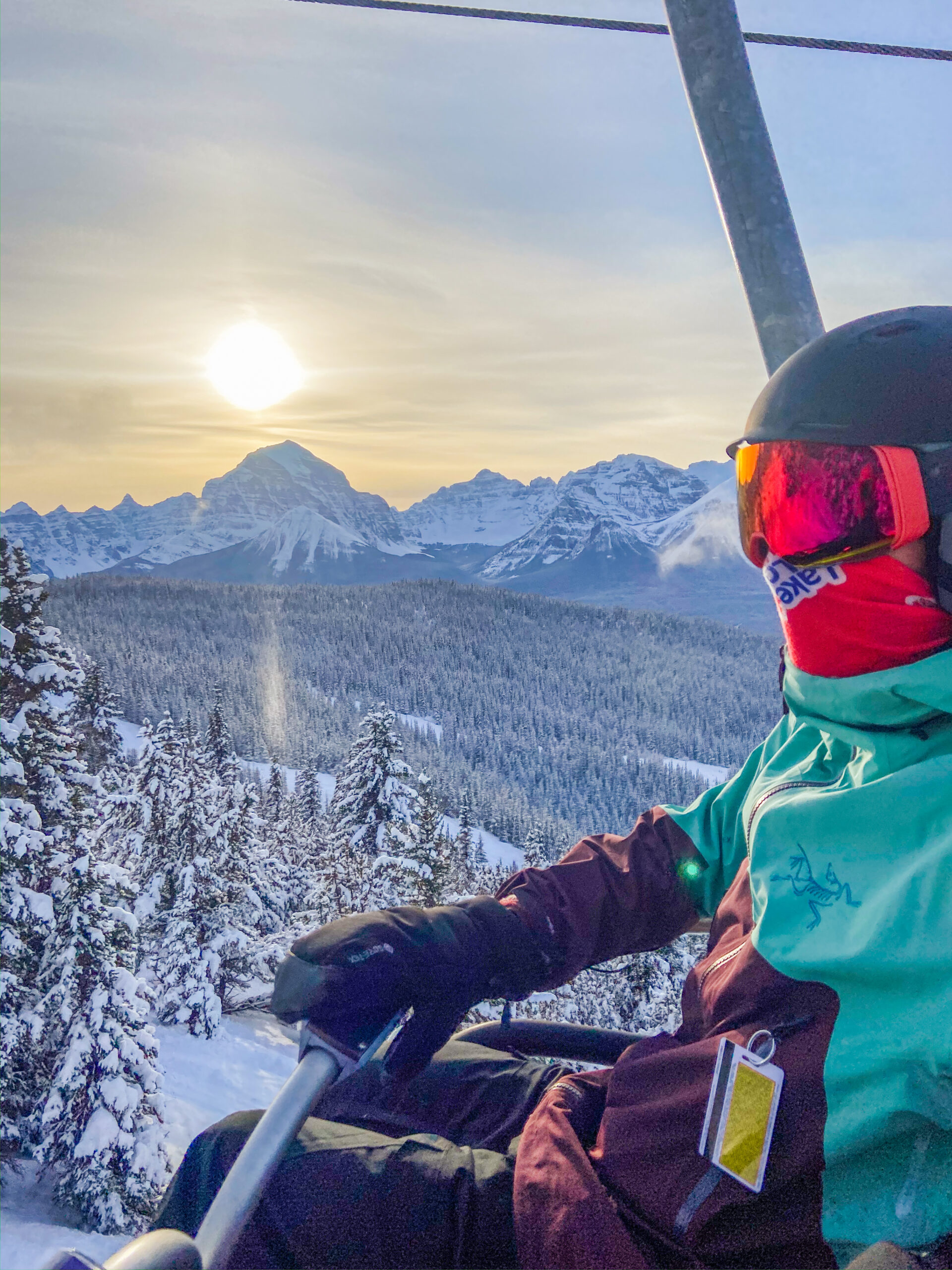
It’s always good to pack some snow protection for your face. On sunny days, we’ll go without anything, but more often than not, we expect snowy conditions on the mountain. We generally switch between two different styles of face protection. A Merino wool balaclava is the primary item for bad weather and cold days.
We’ve tried a bunch of different balaclavas and it’s tough to get one that doesn’t collect tons of moisture before freezing to your face. As for the best warmth and performance, we’ve found a wool balaclava can do wonders. Our next choice would be a fleece one that can be bought super cheaply!
Goggles
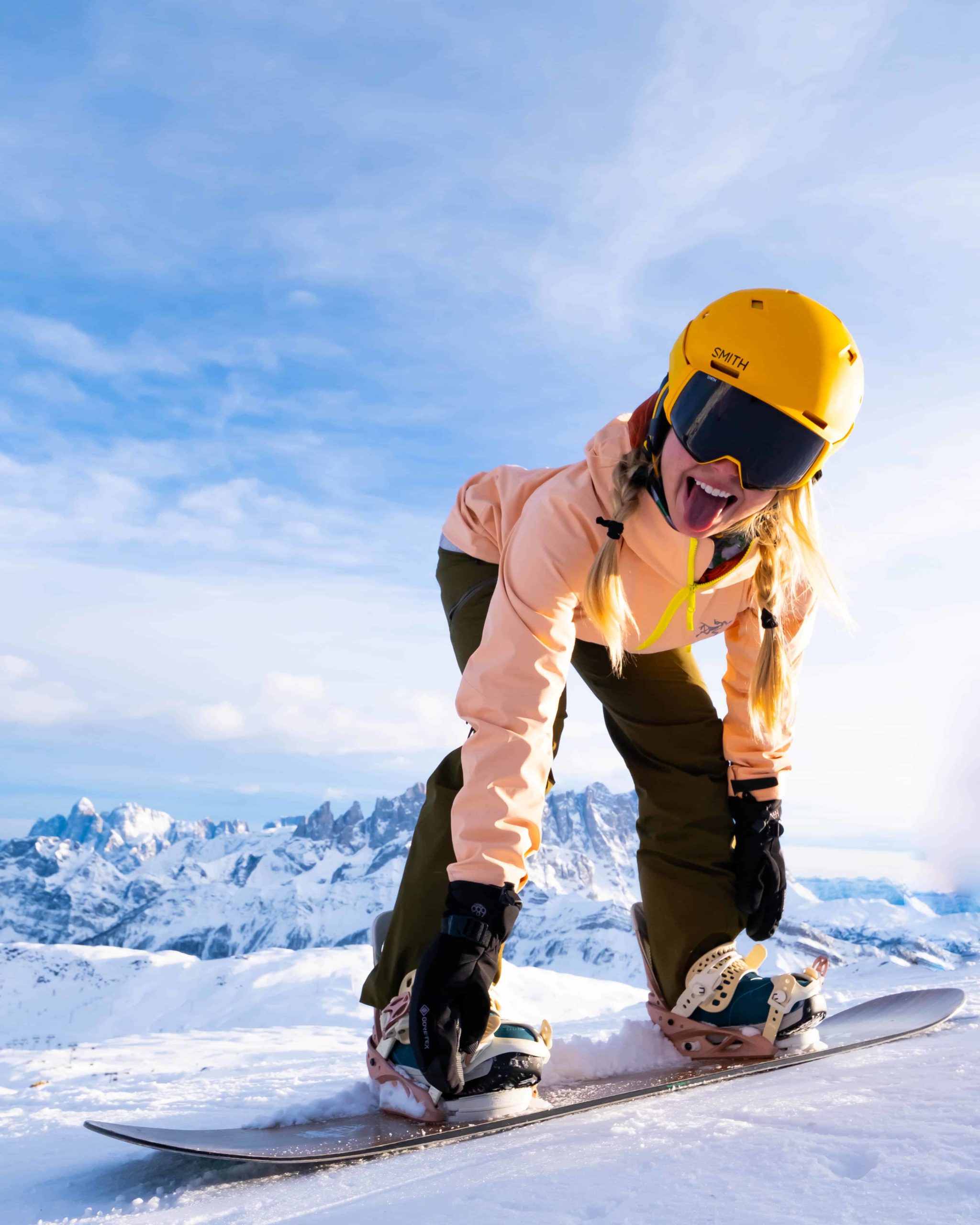
Unless you’re on a budget, don’t care, and take a short weekend trip with guaranteed sunshine, I recommend packing a pair of goggles. They are an essential part of your ski outfit, and I consider it a lifeline. Goggles provide protection for your eyes and aid your vision on the mountain.
We have long been fans of Smith Goggles for their unrivaled optics quality and low-light performance. Their latest goggles have mag technology in their goggles for easy switches between low light and sunny days. Even if you don’t want to drop $200 on goggles, it is worth picking up a good budget option. For less than $100, you can grab the Giro Roam, which includes two lenses for low light and sunny days.
Ski goggle rentals are tough to come by, so if it’s your first time, opt for the Giro Roams or order a cheap $50 pair off Amazon. It will save you a lot of headaches on the mountain.
Helmet
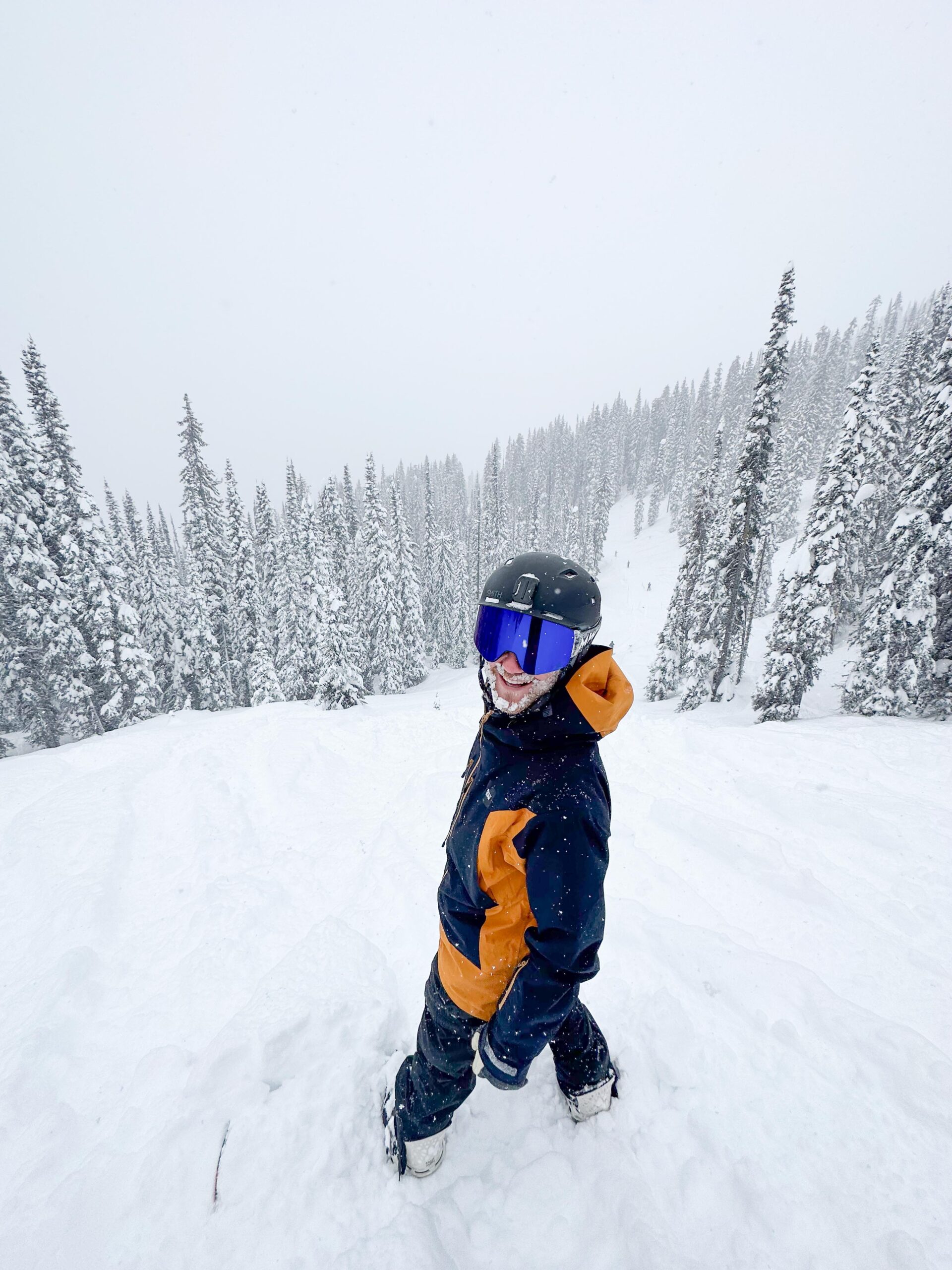
Not wearing a helmet is a thing of the past. Do yourself and your noggin a favor and wear a helmet when you ski or snowboard. This applies whether you are a beginner or an expert. The great thing about helmets is they keep your head and ears warmer than hats too!
We rock the Smith Vantage Helmet as it’s considered one of the best helmets on the market. It provides robust protection around our head, plenty of ventilation, and a cozy soft interior.
After receiving a concussion last ski season and wearing a helmet, it’s not something I plan to forgo anytime soon. If it’s your first time traveling with ski gear, carry your helmet onto the plane strapped to the outside of your backpack. Don’t worry if you don’t own equipment. Every ski rental shop should offer helmets.
What You Don’t Need to Bring to Banff in Winter
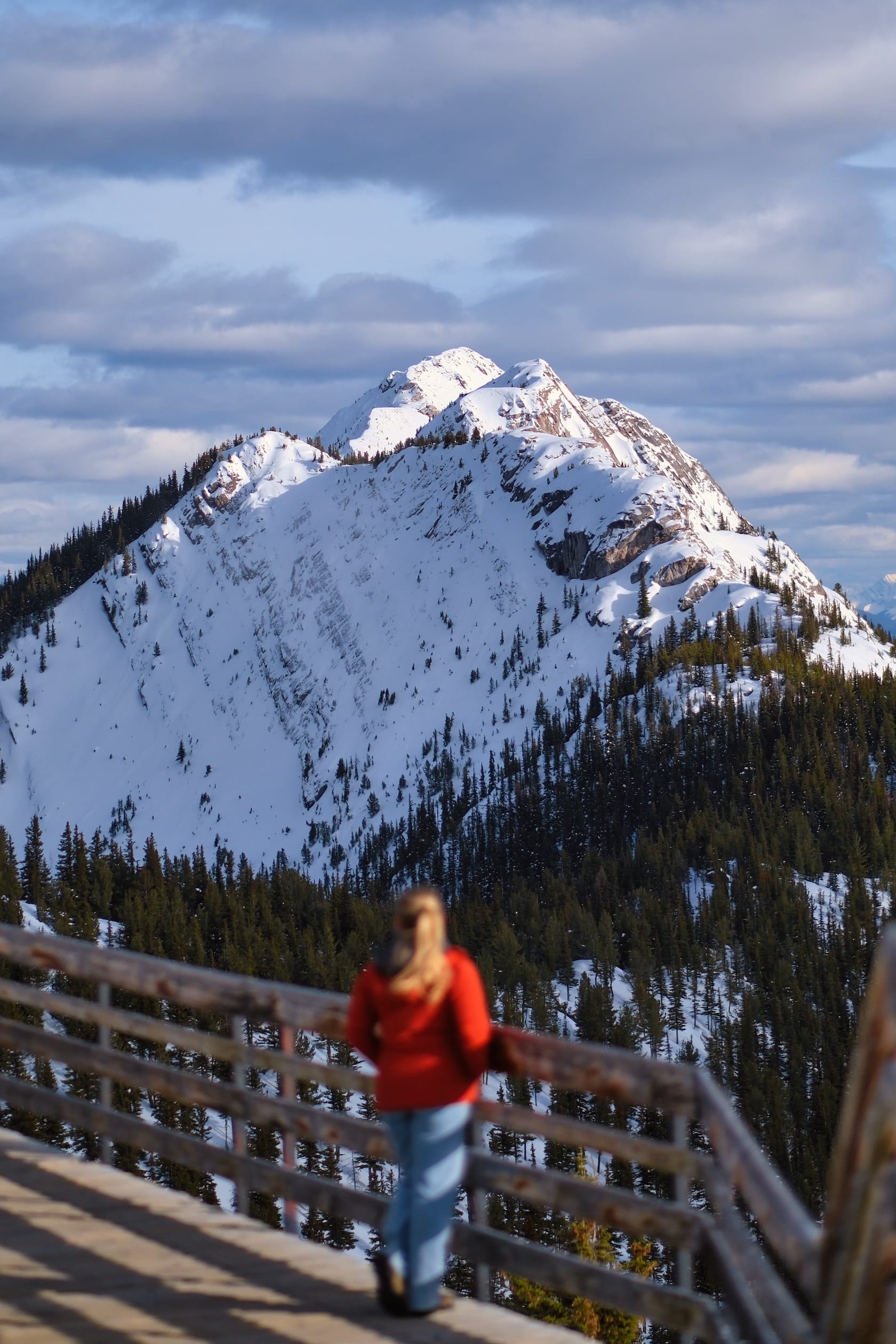
- Club Dresses: There really aren’t many clubs in Banff or Canmore, besides the Dancing Sasquatch in Downtown Banff where the Aussie workers hang. There is no need for a short clubbing dress. The best thing you’ll find here is a brewery or distillery where you would instantly feel out of place in a short dress.
- Heels: There’s absolutely no scenario in the Canadian Rockies where you will need heels, especially in the winter. Oh yeah, and don’t go hiking in them – that’s a bad idea.
- Super Dressy Clothes in General: Both men and women don’t need to worry about getting super fancy here unless you want to or have a very nice evening planned. A cute sweater and black pants work just fine if you’re going to a nice event. If the ladies really want to dress up a nice sparkly skirt with tights and a nice sweater.
- Bottled Water: The one thing that drives me nuts every summer is the grocery stores that sell cases of bottled water and the visitors who think they need to buy them. Not only is this a waste of plastic, but it’s truly unnecessary with the excellent water quality in the valley. There is no need to worry about the tap water here. It’s SO good and completely fine. Please don’t buy bottled water here.
Where to Get Winter Clothes
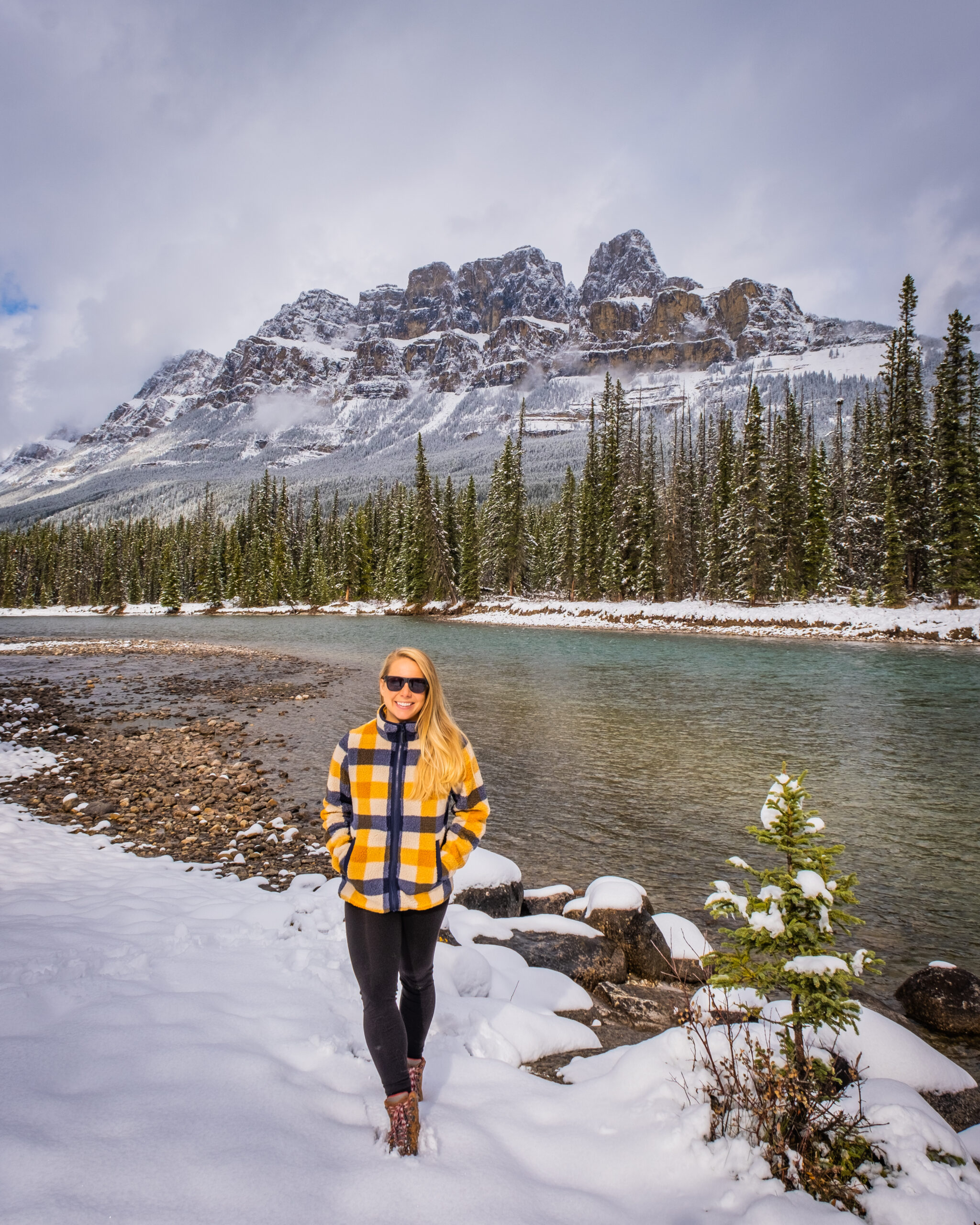
If you’ve forgotten any items don’t worry, there are plenty of places to purchase winter necessities in the Rockies. From high-end to low-cost, you can get almost anything you need on Banff Avenue. Other places to head are:
- Switching Gear in Canmore: Consignment shop specializing in outdoor goods.
- Canadian Tire and Marks: You can find cheap “workman” like gear here. Marks often has specials on sweaters, socks, hats – you name it!
- Valhalla in Canmore: Outdoor store with all the latest goodies.
- Atmosphere in Banff: From camping equipment to boots, you can find all the name brands here.
- Columbia Store in Banff: For mid-range outdoor apparel at a reasonable price.
Plan Your Trip to the Canadian Rockies
- We now have an interactive map! With over 350 stops and pre built itineraries around the Canadian Rockies, our personal map and guide is your one stop shop to an epic trip here.
- Recommended Experiences: There are many things to do in the Rockies, but our top recommendation is the Banff Gondola – a must do experience! Want to get up close and personal with a glacier? We cannot recommend this Icewalks tour enough! See more of our recommendations.
- Planning your visit to Moraine Lake and don’t want to deal with the Parks shuttles? We recommend using Moraine Lake Bus Company, Fairview Limo (leaves from Lake Louise Village) or booking with ViaVia (these leave from Banff/Canmore).
- Hotels in the Rockies: There are many places to stay, from luxury hotels to wilderness cabins. See all our favorites here.
- Get Around: We suggest renting a car to get around. You can search for rental cars on Discover Car. For a campervan trip, you can check prices and compare on Outdoorsy. Don’t forget the Guide Along Audio App for driving the Icefields Parkway (Use our link for 25% off!)
- We can help you plan your 2025 trip to Western Canada! If you’re feeling overwhelmed by planning we can assist! We’ll hop on a 1 on 1 phone call, and PERSONALLY go over your itinerary, and will save you previous time and money with our personal recommendations. Calls are followed up with detailed trip notes afterward that I write myself. See our services here.

